All About Planners
Printable planners to organize your home, business and life!
April 26, 2022

How I Planned a 6 week European Holiday (Plus download my detailed Itinerary)
As I’m sure most people (especially Australians) would agree, COVID hung around a lot longer than I thought it would. With international travel finally back on the cards, I’m starting to plan future trips, particularly future holidays to Europe.
To plan my trips I use a mix of Excel spreadsheets (you can use them in Google Sheets which is like a free online version of Excel or Number for Mac) and an itinerary template I created in Microsoft Word .
I find other blogger’s itineraries and tips for planning itineraries very helpful, so wanted to share my own Europe trip planning process.
Warning, if you’re not a type A personality and don’t like to plan detailed itineraries, this post might not be for you…
Things I consider when planning a Europe trip
I have a very detailed post with the 50 Things to consider when planning an itinerary . But in this post I really wanted to get specific about planning a Europe itinerary.
I use a similar method for planning any holiday:
- Order of countries I’m visiting
Timings & how long to stay in each city
- Time of year visited – seasons, weather, opening hours for main attractions
Train versus bus versus plane
Diy day trips versus pre-booked group tours.
- Will the trip be too long?
- What could I change about this itinerary?
- What are my ‘must visit’ versus ‘good to visit’ destinations
I consider the cost when booking things like train versus a plane, type of accommodation and day tours. However, budget is not my main concern. I’m not going to skimp on cost and take the view that it costs whatever it costs. Past trips usually end up being about 15% more than I initially expected and I’m totally fine with that. I will not sacrifice decent accommodation and a good night sleep, or use an airline with a poor safety record, just to save a few dollars.
Countries Visited (in this order)
The trip was 45 days including travel days. I lose minimum 24 hours traveling each way to / from Australia. Half day transit each time I leave a destination is included in the timings for each country in the list below.
- Travel day – flight from Australia to Copenhagen (1 day)
- Denmark (2 days) – Copenhagen
- Finland (6 days) – Helsinki & Rovaniemi
- Estonia (3 days)
- Latvia (3 days)
- Lithuania (3 days)
- Netherlands (5 days)
- Belgium (3 days)
- Luxembourg (1 day – day trip from Brussels)
- Czech Republic (5 days)
- Croatia (2 days)
- Slovenia (3 days)
- Germany (7 days)
- Travel day – flight home to Australia (1 day)
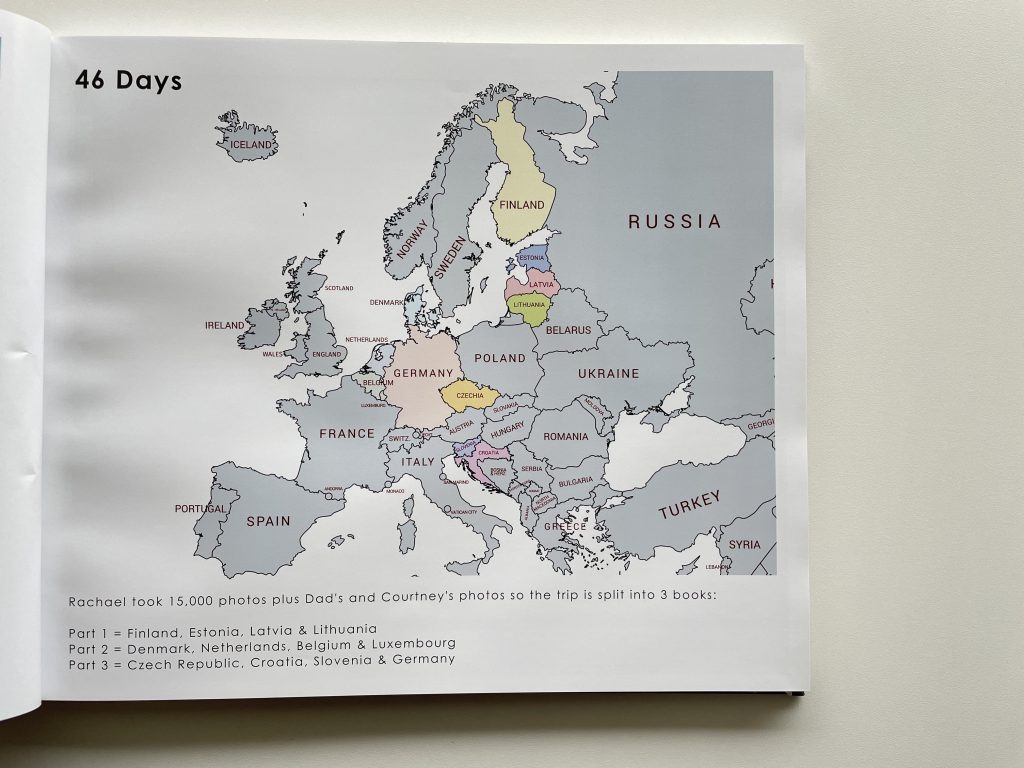
Tutorial on how I make my travel photobooks is coming soon!
This order may appear odd, zig zagging across Europe, but there are very good reasons for that which I’ll explain more in this post.
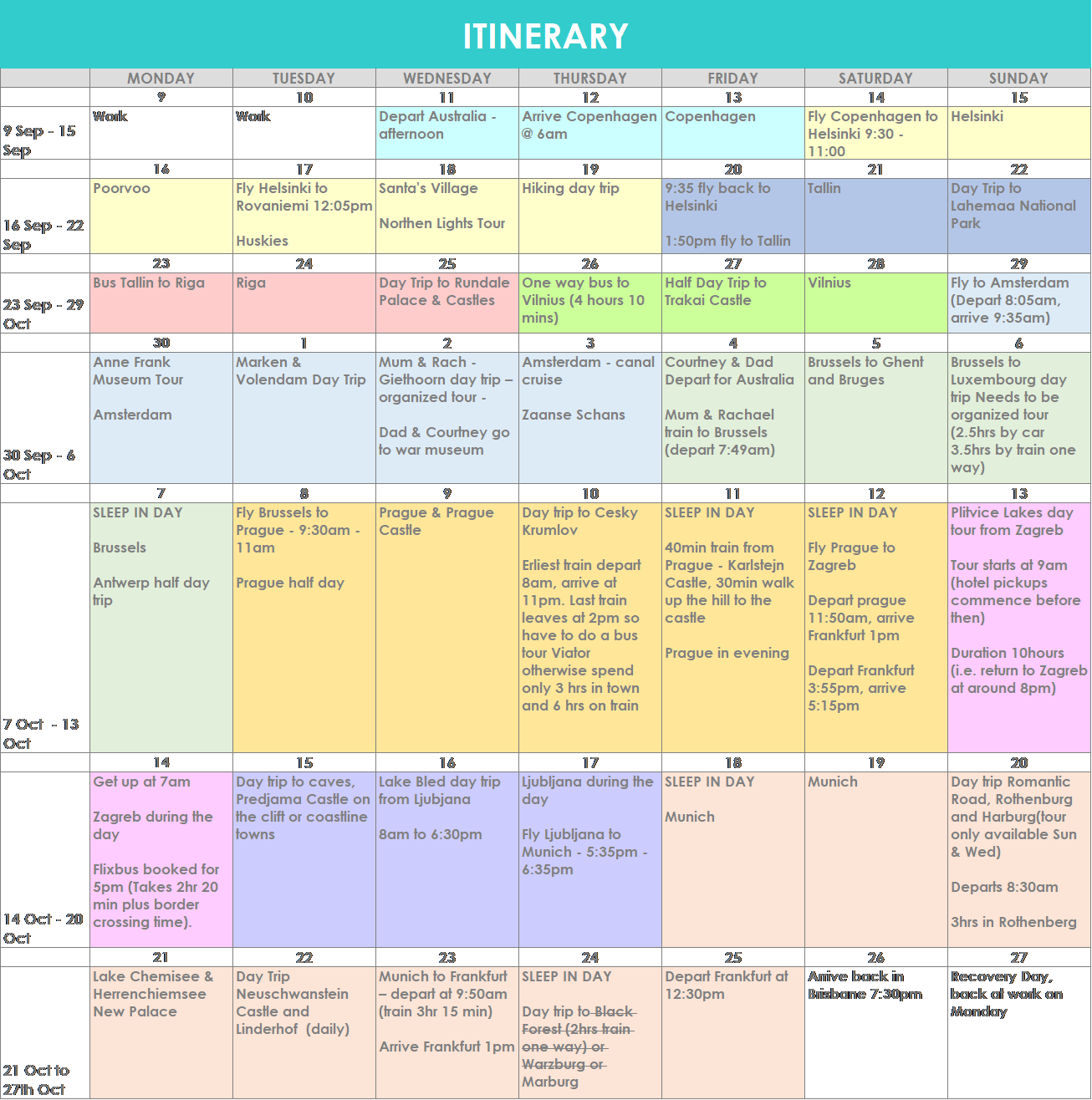
Related post: How I plan and make travel photobooks (plus download my workflow printable)
Download a copy of my itinerary
If you’d like to download a copy of my detailed itinerary for this holiday, click here.
Why I visited the countries in this order
I departed September 11th and arrived back October 26th. I debated the country order a lot but in the end I wouldn’t change the countries visited or the order that I visited them.
- I always take the view that, if, for whatever reason I couldn’t get back to Europe for a while what would I regret not seeing and doing? (Covid arrived 3 months after I got back from this trip so I was glad I had taken this approach!)
- I was doing part of the trip with my sister who really wanted to see the northern lights in Finland
- I was travelling with my Mum – what things interest her and what places does she want to visit? She’s not getting any younger, so what activities do we want to do now while we’re both fit and healthy?
- We wanted to see autumn colors so I started with the northernmost countries as the Autumn colors would descend down the continent as the month went on. I researched what time of year autumn colors typically arrived in each of those countries and that influenced the country order as well
- Avoid Oktoberfest in Germany. I have zero interest in drinking and partying and I wouldn’t go to Oktoberfest in any country (let alone Germany), even if you paid me to go. Accommodation in Munich was also more expensive and hard to find during Oktoberfest
- Geographical distance, travel time & transport connections. Latvia and Lithuania weren’t even on my list. However they are right next to Estonia which was on the list. It’s only approx. 4 hour bus ride between these countries, they’re cheap to visit and not over-run with tourists yet so I figured why not add them to the list?
- Belgium is an easy train ride from the Netherlands. Could take an early train so can have most of the day in Belgium
- Prague had very limited flight options out of the country. No matter what countries I ordered after it in the itinerary, we had to do a stopover in Frankfurt to get anywhere other than the ‘big’ places like Paris. Brussels had a direct flight to Prague so we managed to avoid a stopover on the way there
- We only spent 2 days in Croatia. It wasn’t on the list either however, Zagreb where you can take a day trip from to the Plitvice Lakes, is a short bus ride from Ljubljana and we knew we wanted to go to Slovenia.. so Croatia was added to the list
- I don’t like to spend more than about 5 days (including day trips) in one place. I usually do 8am to 6pm or even 8pm itineraries so after 5 days in a major city like London or Paris I’ve had enough of a taste and am ready to explore something new
- Day trip options. I spend at least half as long as the actual holiday just planning the holiday. I enjoy itinerary planning and like taking my time, but day trips is one of the most frustrating things to coordinate. Some tours only operate on certain days of the week, or you need a morning tour but it’s only offered in the afternoon. I don’t want the hassle of hiring a car, figuring out how to drive in another country and no doubt getting lost, so lesser visited countries and attractions like the Plitvice lakes were planned around a weekend in order to do the day trip
We were actually only going to go for about 4 – 5 weeks, but Europe is so accessible once you get there and everything is so close which is how the trip ended up being 6.5 weeks.
Another thing I considered was a ‘travel to do list’ I created years ago, of all the countries I wanted to visit before I turned 30 and roughly in what order and at what time of year. I clustered places I wanted to see at certain times e.g. Alsace region of France at Christmastime, autumn colors, a Christmas markets European river cruise etc. So I tried to leave those places out, or if places were on this itinerary, I’d be happy to visit them again at another time of year e.g. I could go back to Amsterdam at springtime to see the tulips and it’s a hub to go in and out of Europe anyway so am likely to fly into Europe via there next time I visit.
This was my original travel plan I did in my digital notebook. . before I knew how long covid would drag on.
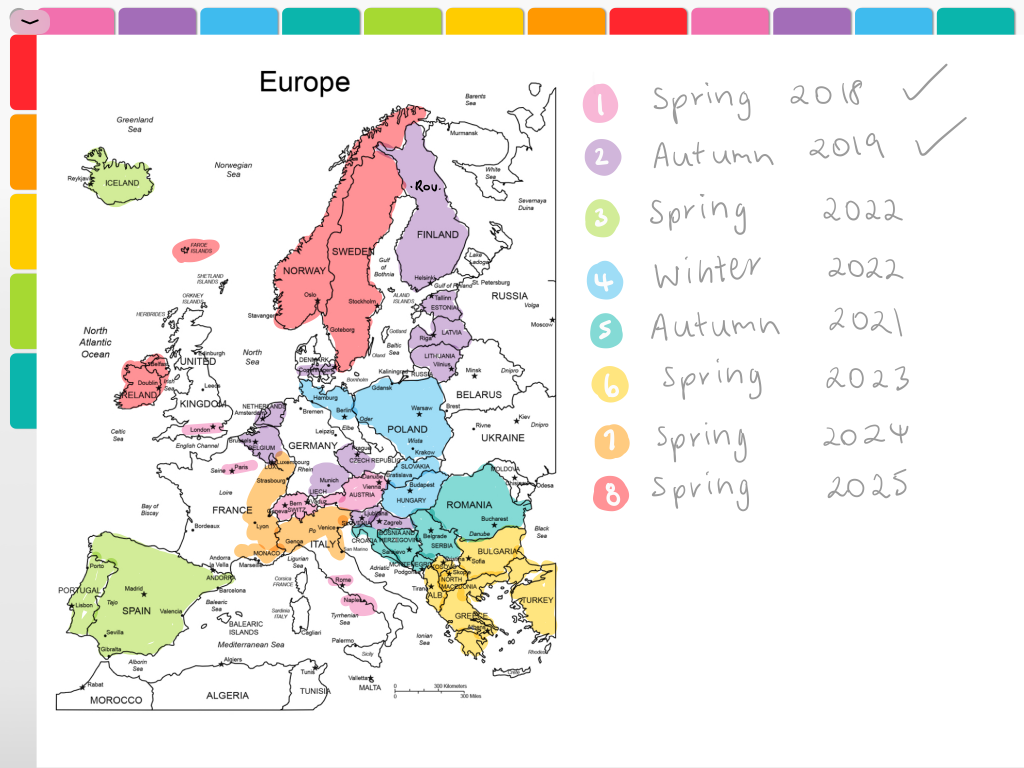
Arrival country
The first country we were going to visit was actually supposed to be Finland to meet up with my sister who had been in Russia prior. However , there aren’t any flights from Australia that will go directly from the key stopovers (Singapore, Dubai, Doha) to Helsinki. The only way to get to Helsinki was by flying through these stopovers and having another stopover somewhere in Europe.
The best option for flight times with the least amount of wasted time and for a reasonable price, was actually Copenhagen, Denmark. Quite odd as it’s an expensive destination once you get there. But then I thought, actually, that works out well. I’d be happy to go there and I’m not deliberately paying for a flight to get to Copenhagen, plus it aligned with a flight 2 days later that would go to Helsinki so I could land at 6:30am and have 2 full days in Copenhagen. Sold!
Another reason I thought Denmark would be good, is that less people are likely to go there as it’s so expensive, so the plane might not be as full. And it wasn’t. My Mum and I managed to have an empty seat between us on both legs of the flight there. Which really makes a difference when you’re flying cattle class.
I liked Nyhavn so much I made it the cover of my travel photobook
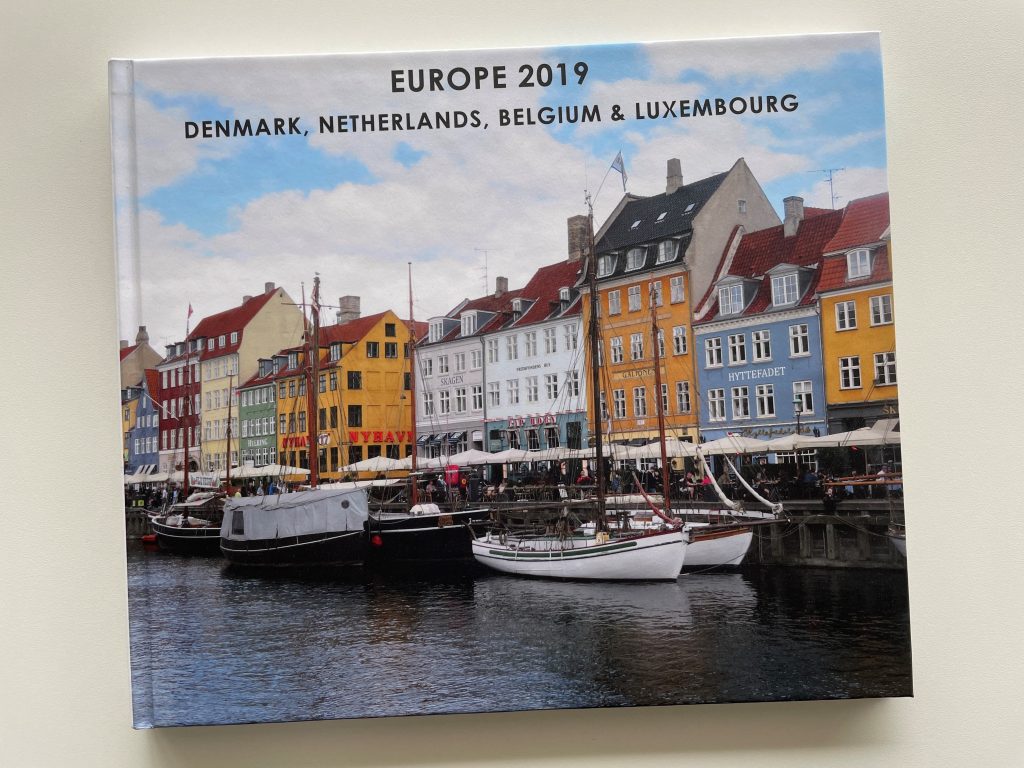
I will only fly on airlines that have a reputable safety history and I will happily pay extra for this. This does eliminate a few flight path routes to Europe, but the time is always about 24 hours, one way from Australia no matter which way you go anyway.
Another thing that I’ll admit was in the back of my mind. We were departing on September 11th… Just in case in the extremely unlikely event of something like a flight highjacking happening again on that anniversary, I will admit I didn’t bother looking at flight routes that went via the USA.
I will also only fly long haul with airlines that allow a decent baggage allowance (about 32kg per checked bag). On long haul for 6 weeks I knew my bag would probably end up near that weight by the time I’d finished buying chocolate, stationery and whatever else I found. I don’t want the hassle of having to pre-buy extra baggage or dealing with airport staff buying extra luggage allowance at the check in counter.
I have flown via Singapore’s Changi airport both times I’ve been to Europe and really like that airport – very easy to navigate

If I can avoid getting on a plane in Europe, I do it. Train travel and bus travel are easy, inexpensive options.
- Most depart from the central station where the accommodation is near so don’t need to lug suitcases far
- Reasonable price and can get plenty of deals with a Eurostar or Eurail ticket
- Scenery out the window to look at
- There are usually tv like screens in the carriage telling you what stop is next, as well as a verbal announcement. You can also track where you are via Google Maps on your phone so I’ve never needed to ask a stranger for directions at a train station
- Less security. Once I enter the Schengen there’s no airport style security, it’s just like boarding a normal train. If you take a flight from a Schengen country to another Schengen country, you have to get to the airport really early and go through security. The time isn’t worth it for a short flight
- If you’re taking a long distance train and depending on the company, you can pre-select your seat when you buy the ticket (it may cost a few dollars extra)
- Most stations have lifts to the platform but there is the risk that they might not. For whatever reason I noticed there was usually a large step from the train down to the platform so keep that in mind
- Can walk around the train carriages
- No plane toilet, train toilets are usually cleaner
- Most arrive at the central station where again, I typically book accommodation so don’t need to lug suitcases
As for taking the bus, I prefer to take the train so have only done the Lux bus around Estonia, Latvia and Lithuania and the Flixbus from Zagreb to Ljubljana. The Lux bus was great. TV screens on the back of the seats, hardly anyone on the bus so you could spread out, no designated seats, curtains to block out the light. I’d use it again.
Read more: Lux Express Bus Review (best way to travel between the Baltic countries)

I had heard many stories from other people saying the Flixbus does not wait and will leave without you if you are late. I was so paranoid about this I didn’t drink any water so I wouldn’t need to get off the bus at one of the designated rest stops to go the toilet and risk them driving off without me! Apart from this paranoia and the bus driver not speaking English, the Flixbus was great. Only $20 AUD for a 2 hour bus ride, comfortable seats and they lifted my luggage in and out of the hold underneath the bus. I’d take it again for bus trips 4 hours or less and if the timings worked with my itinerary.
I thoroughly researched everything so had a very good idea of how long it would take to get between places, which days I could switch based on weather, how far things were from the hotel etc. I spend so much time pouring over itineraries that I can basically recite the entire thing off by heart by the time I actually go on the trip.
Most of the days were 8am to 8pm. We fit in absolutely everything we wanted to see with no regrets and didn’t feel like we missed out on anything.
For me, the more well-known ‘big’ cities (e.g. London, Paris, Amsterdam) need 4 – 5 days and smaller cities (e.g. Prague, Vienna, Copenhagen) need 2 – 3 days to see the highlights. These timings do not include travel which may be half a day on each of the arrival and departure days. I usually do 1 – 2 full day or half day trips in each city which is included within these timings.
The only thing I’d change was that I didn’t need 7 days in Germany. I could’ve removed the day trip from Frankfurt to Marburg and the day trip from Munich to Lake Chiemsee HerrenChiemmse Palace (if you’ve been to Versailles don’t bother, you’ll be underwhelmed). Instead I would’ve either reduced the length of the trip, or added another part of Germany to get some more variety into the itinerary (I should’ve added more of the romantic road).

You can download a copy of my full itinerary here . If you prefer a slow pace of travel, you might need to add a half day or day in each city.
Time of year visited
I think September to October (autumn) was a great time of year to visit Europe. I have also been in April to May (spring) and really enjoyed that too. Visiting Europe during the summer months doesn’t interest me. Too many crowds of tourists, too hot (my chocolate snacks will melt!) and plus I’ll want to drink more water and if you’ve been to Europe I’m sure you aware of the toilet situation (or lack of). Prices can also be higher and depending on where you go I think it could be very difficult to find a restaurant for dinner without pre-booking.
So if you’re not sure when to go, try the shoulder season (April to June and September to November).
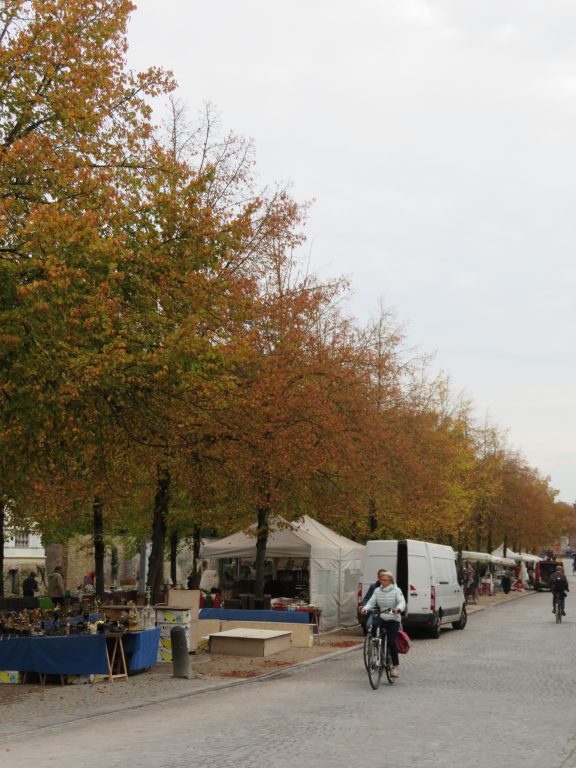
Related post: Bruges and Ghent day trip from Brussels via the train
In less popular countries like Slovenia, the day tours don’t run every day and when they do, it’s a mini bus. There were only 4 – 6 people plus the tour guide on tours. It was far more enjoyable not having to wait for the stragglers, people had more of a say in the timings of things, they add little extras like ‘here’s a nice viewpoint let’s stop for photos’, they can buy tickets for you saving you time (and sometimes can swing a small discount for you too), you could ask the tour guide for restaurant recommendations, they’d talk about their life in that country. Overall just a much better, more personalised experience.
These tours can cost a bit more just because there are no other day tour options and obviously not as economical as operating a giant bus but I much prefer this style of travel.
You don’t get any of that on the big tour groups. I once had one where I was sitting at the front of the bus and could see the reflection of the tour guide in the windscreen… she was reading word for word off of palm cards!
Compare that to the tour for Neuschwanstein where there were 70 people on a 2 level bus and Grayline tours had 3 buses of that size departing on a single day (this was in October – shoulder season), I’d hate to know how crowded it gets in the summer.

Why do day tours instead of on my own? Some places you have to have a car to get around and I don’t think it would be possible for me to fit everything into 1 day. Directions, parking, finding a place to eat. Tour guides know where to go, have arrangements with restaurants, reserved tour bus parking. It makes it much more efficient. They usually have the timings down pat if they’ve been running the tour for a few years and sometimes I think I’d like a bit more time and some less, but I’ll take that trade off for just being able to go there. If it’s a choice between hiring a car or taking a tour I’d take the tour. But if there are trains and buses easily accessible I would rather do it myself.
If you were an influencer or professional photographer you’ll probably need an overnight in places like Rothenberg because there’s no way you’re going to get the perfect shot in the limited time on an organized day tour.
I purchased a train ticket from Amsterdam to go to Zaanse Schans, The Hague and then back to Amsterdam. But there were only certain trains that the ticket allowed (think it was non-express trains only), so we had to wait half an hour for the right train. If you were on a tour bus you wouldn’t have this problem so pros and cons for doing / not doing an organized day tour.
You can see the level of detail I go into when I plan a day trip myself versus joining an organized bus tour in my itinerary for this trip .

Related post: Day trip via train from Amsterdam to Zaanse Schans and The Hague
Was the trip too long?
Yes. The first Europe trip I did was 5.5 weeks. I felt this wasn’t quite enough. The second trip was 6.5 weeks. I felt like this was a little too much. I think for me the 6 week mark is the sweet spot. At the pace I travel it’s usually 20,000+ steps per day, going to viewpoints at night so getting back to the hotel late, getting up early the next morning for a group tour or to be at an attraction at opening time to avoid crowds and get good photos. By the 6 week mark I’m too tired to continue going at that pace.
If you travel at a slower pace you could spend a bit longer but once I spend about 5 days in one city I feel like I’m done, I’ve seen the highlights and I’m ready for a different city or country.
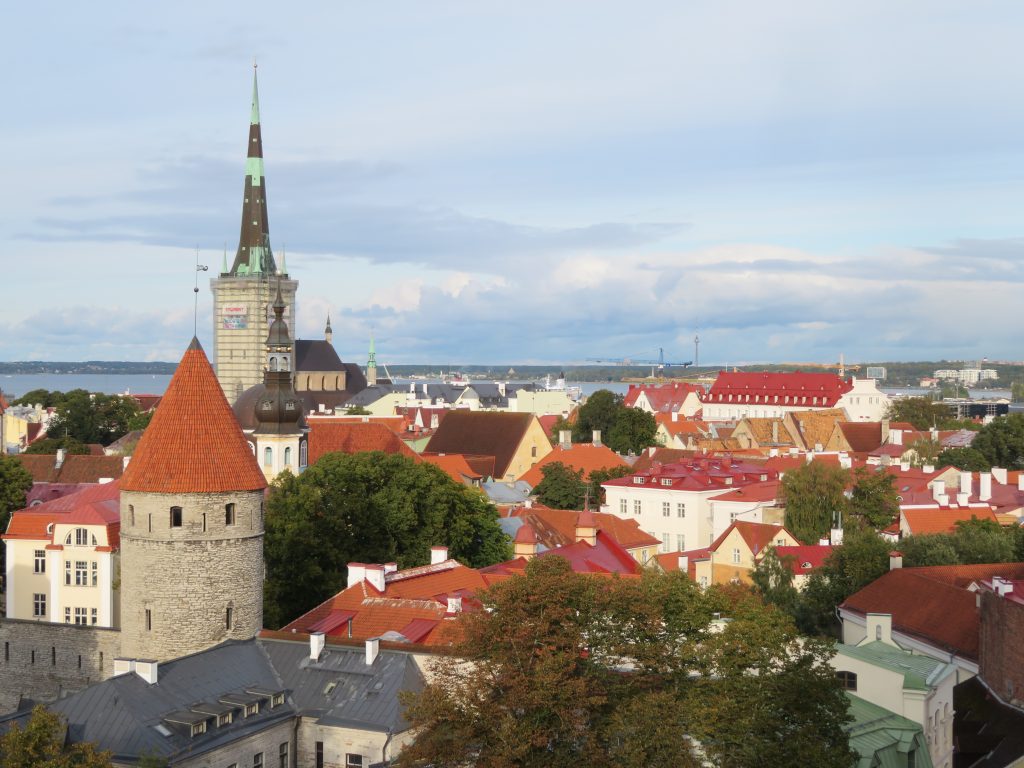
Read more: Tallin’s best viewpoints
What would I change about this itinerary?
Not much! I thoroughly research and planned everything so I was really happy with how the trip went. The only thing I would change is spending more time in Luxembourg (overnight instead of a rushed day trip where 6 hours was spent on a bus). It’s not far from Colmar and Alsace so I can add Luxembourg into a Christmas markets itinerary I want to do in that area on another trip (and would see it during a different season too).
I didn’t know this was going to happen when I planned the itinerary, but the only way to get from Ljubljana to Munich was on Slovenia’s national airline.. which went bust a few weeks before our flight. We had to re-book flights which sent us up to Warsaw in Poland with a connection back down to Munich (so 7 hours instead of 2 hours). We didn’t want to rush Ljubljana so we opted for the flight (which departed at 5pm). There was a train through Austria which left in the morning and would’ve taken the same amount of time and I’m sure would’ve been very scenic. If I’d known the issue with flights was going to happen before the trip, I probably would’ve rejigged the itinerary and opted for the train instead.

You can download a copy of my full itinerary here .
You can copy parts of my itinerary or gain an idea of what you can fit into each day at each destination. I split each day into morning and afternoon.
I hope this gave you some ideas for planning your own European holiday!
More travel tips
- Travel Planning: 50 Things to consider when planning an itinerary
- How I use Excel to organize all my travel plans (research, itinerary, hotel, tours, bookings, packing list etc.)
- Travel Planning: How to choose a hotel (my step by step process)
- Visit a City versus Google My Maps: which is better for visually planning your travel itinerary
- How I plan and make travel photobooks (plus download my workflow printable)
- 115 Things to Google before your next vacation
Europe itineraries
- 50 Things you must see and do when visiting London
- Guide to Visiting the Isle of Capri (Itinerary & Tips)
- Copenhagen Weekend (2 Day) Itinerary (What to see & do and best photo spots)
See all travel posts here
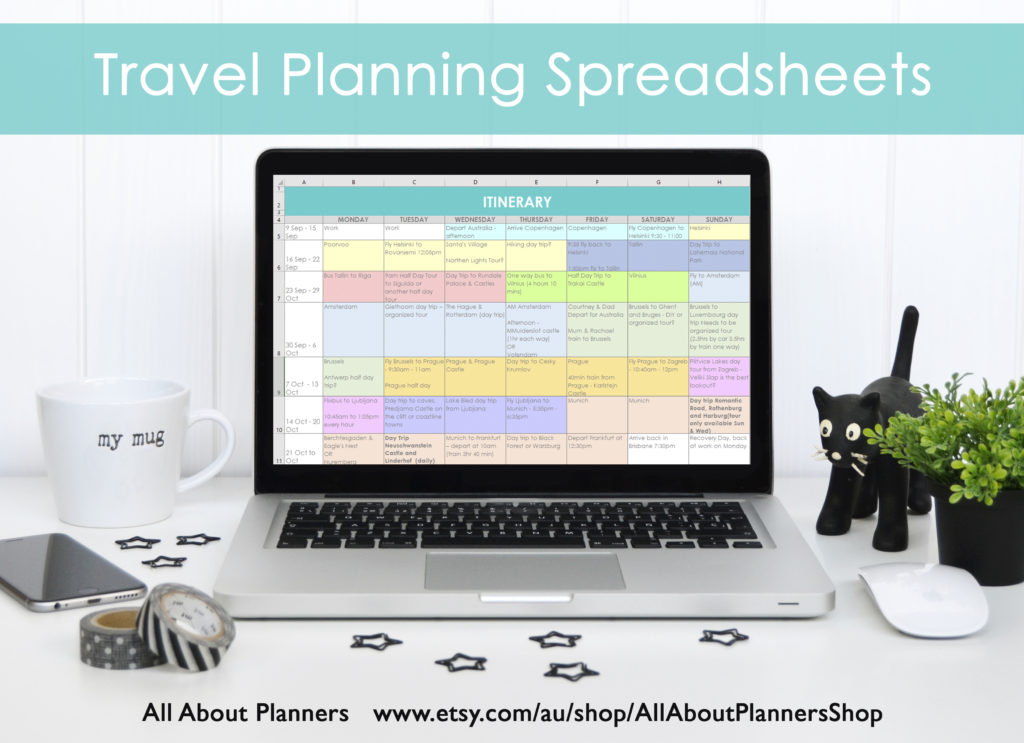
Liked this post? Pin it!
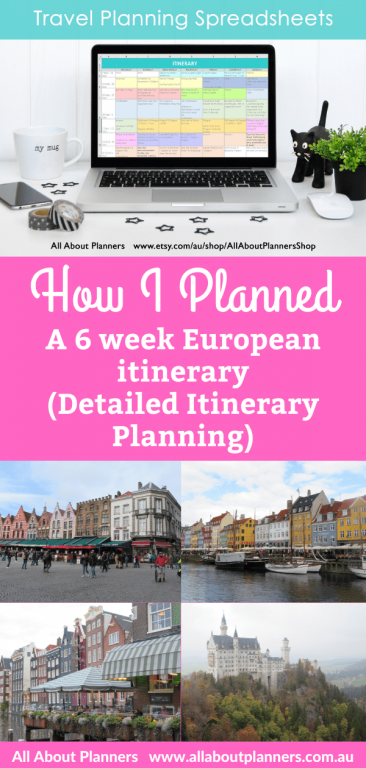
Share this:
- Click to share on Twitter (Opens in new window)
- Click to share on Facebook (Opens in new window)
May 9, 2022 at 11:22
sweet! I was a +1 on a week-long Italy trip and everything was planned out by that company and it would have been nice to make my own wanderings. Most certainly will next time on my own!
Leave a Reply Cancel reply
Your email address will not be published. Required fields are marked *
Save my name, email, and website in this browser for the next time I comment.
This site uses Akismet to reduce spam. Learn how your comment data is processed .
Copyright © 2024 All About Planners · Theme by 17th Avenue

Navigate forward to interact with the calendar and select a date. Press the question mark key to get the keyboard shortcuts for changing dates.
Navigate backward to interact with the calendar and select a date. Press the question mark key to get the keyboard shortcuts for changing dates.
Europe Trip Planner
Top destinations in europe.

Top attractions in Europe

Other notable attractions

Explore nearby places
- Mazerolles-le-Salin
- Grandfontaine
- Roset-Fluans
- Ecole-Valentin
- Avanne-Aveney
- Saint-Loup-Nantouard
- Chatillon-le-Duc
All related maps of Europe
- Map of Europe
- Map of Burgille
- Map of Marnay
- Map of Recologne
- Map of Etrabonne
- Map of Hugier
- Map of Vitreux
- Map of Mazerolles-le-Salin
- Map of Moncley
- Map of Autoreille
- Map of Franois
- Map of Grandfontaine
- Map of Roset-Fluans
- Map of Malans
- Map of Ecole-Valentin
- Map of Osselle
- Map of Pesmes
- Map of Boussieres
- Map of Avanne-Aveney
- Map of Saint-Loup-Nantouard
- Map of Chatillon-le-Duc
- Map of Beure
- Map of Besancon
- Map of Moissey
- Map of Chatenois
- Map of Chalezeule
- Map of Morre
- Map of Montfaucon
- Map of Gray
Europe throughout the year
- Europe in January
- Europe in February
- Europe in March
- Europe in April
- Europe in May
- Europe in June
- Europe in July
- Europe in August
- Europe in September
- Europe in October
- Europe in November
- Europe in December
Q&A about Europe
Add places from guides with 1 click, collaborate with friends in real time, import flight and hotel reservations, expense tracking and splitting, checklists for anything, get personalized suggestions.
4.9 on App Store, 4.7 on Google Play

- Backpacking Group Tours
- Flashpacking Group Tours
- Premium Group Tours
- All Group Tours
- Get a Quote
- Destinations
- Sustainability
- Gift Vouchers
- Educational Trips
Europe Trip Planner
Euroventure specialises in multi-city europe trips – specifically interrail and eurail adventures., check out our resources and tools below to help you plan your european escape.
It can be really overwhelming trying to plan your Europe trip. There are a ton of things to work out, research and eventually book. That’s why we offer as many resources and services as possible. From planning tools and rail trip advice, to fully guided tours , we can help you plan your ultimate Europe trip on your terms.
Use our interactive Europe Trip Planner tool to create your own route.
Use our Europe trip planner map to create your own self-guided route, including any major European destinations – plus some further afield including Russia and China!
The map tool is interactive and super easy to use; you can make a plan without any obligation to book your trip with us. We’ll then send you over our best ideas for your route, plus a price including all your trains and accommodation. If you like the idea of having your multi-destination trip planned for you, you can book it within minutes! If not, no problem – you can still use the planner.
Not sure which destinations to visit? Get some inspiration with our destination guide !
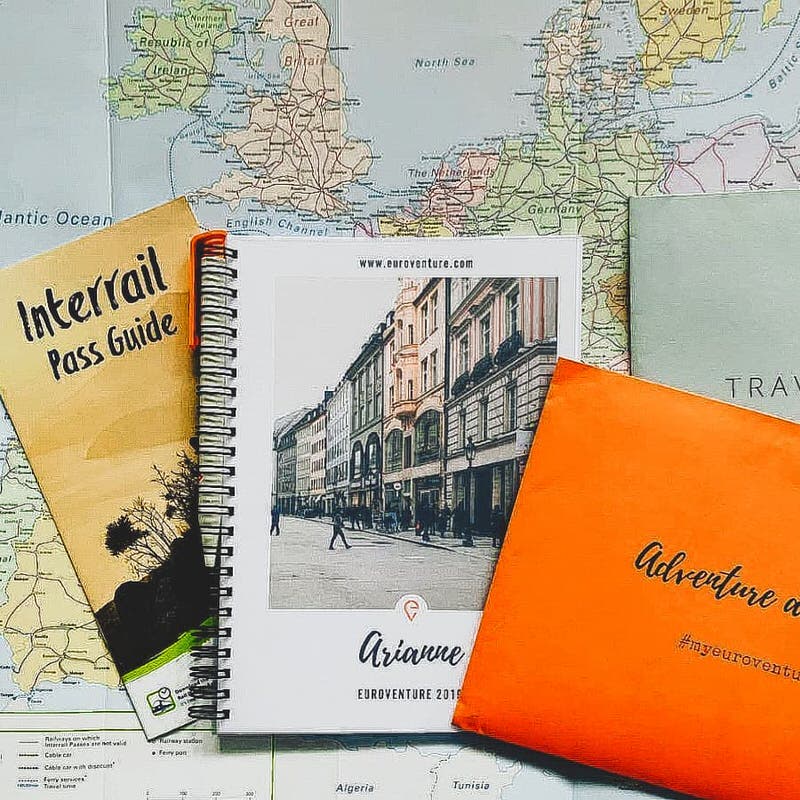
Planning a trip to Europe but need some inspiration? Take a look at our self-guided itineraries.
Choose the route you like the best, and we’ll plan your Europe trip. You travel on your own, or with friends, but we’ll organise everything and send it all to you in a handy travel pack. We can also book activities, attractions and excursions for you. All you have to arrange is a flight to and from your start/finish point, plus your travel insurance (which you can sort through our partners here ) and spending money. Find out roughly how much spending money to take .
Wherever we can, we use trains to get from A to B. They’re the most sustainable, sociable and convenient way to get around – and we’ve got deals with all the main providers plus a ton of expert knowledge! Read more about travelling Europe by train – or check out our comparison of different ways to travel Europe for more inspiration. Scroll down for Europe trip itineraries from 1 – 8 weeks or longer!
If you prefer to travel with likeminded backpackers, why not join one of our small group trips across Europe: Find out more.
WhatsApp us
Easily plan a European rail trip with Eurail Planner
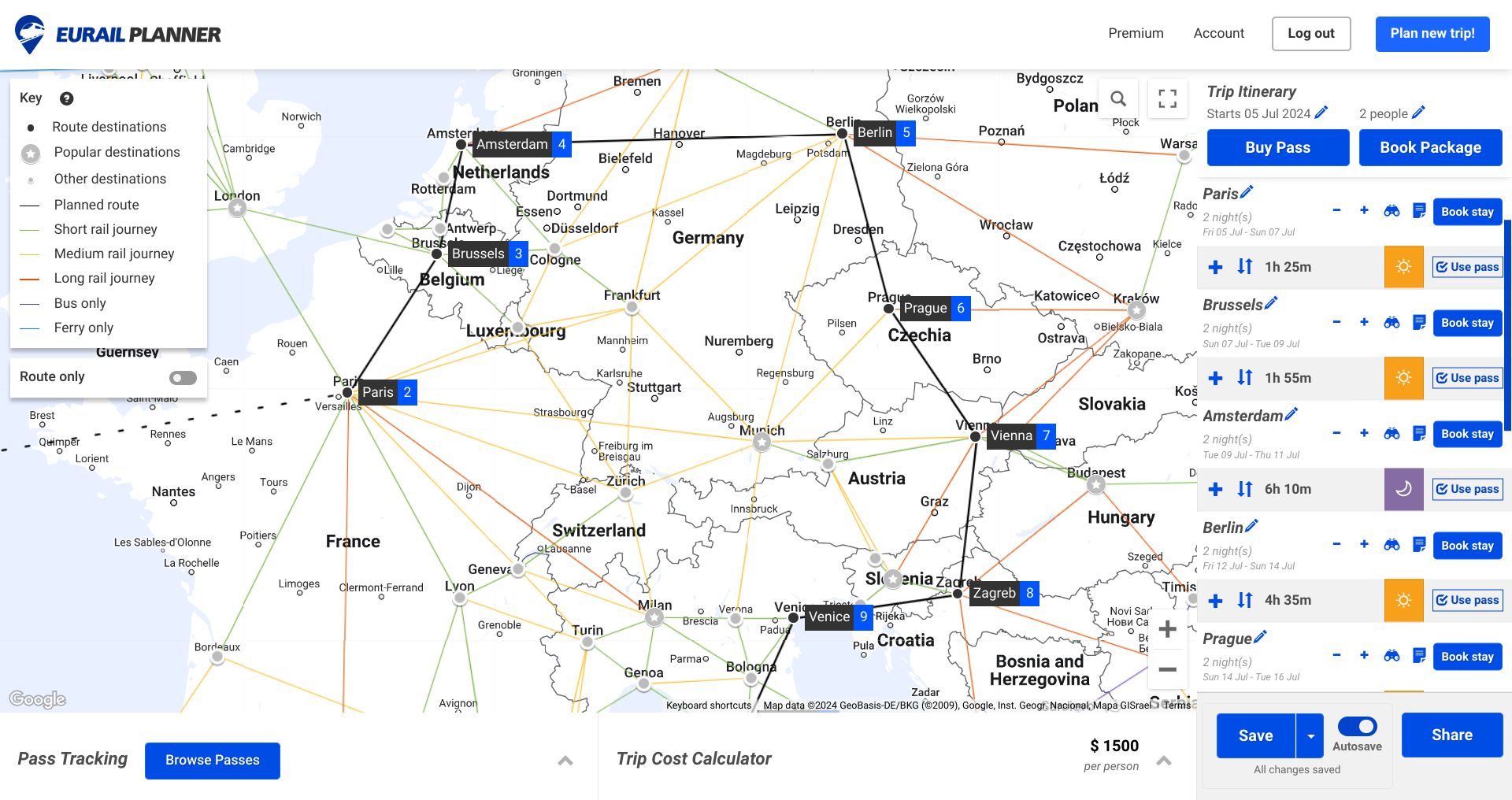
Our free app makes it easy to plan and book everything you need for your trip around Europe.
Plan the best route across Europe and see your eurotrip come to life.
See your day-by-day trip itinerary, so you know when you’ll be in each European city.
Accommodation Search
Instantly search for the best accommodation for the dates and destinations in your plan.
View durations for each rail journey on your route through Europe.
Share your plan with friends and family.
Premium Features
Unlock extra features and exclusive discounts with Eurail Planner Premium - planning your eurotrip has never been simpler.
Track your pass restrictions so you don't break the rules.
Stay in budget with a trip cost estimate that updates as you edit.
Add notes to your plan as you research your trip.
Get exclusive offers with our Premium account.
Multiple Plans
Create & save as many routes as you like.
Most popular Eurail routes
Get inspired by these popular Eurail routes. Each trip can be booked as a standard package or you can customize it and request a quote using our route planner.
Buy your Eurail pass
Whether you want to explore one country, several, or all of Europe there is a Eurail pass to suit your travel needs.

Flexi Global Pass
Travel in 33 countries with a set number of travel days in a 1-2 month period
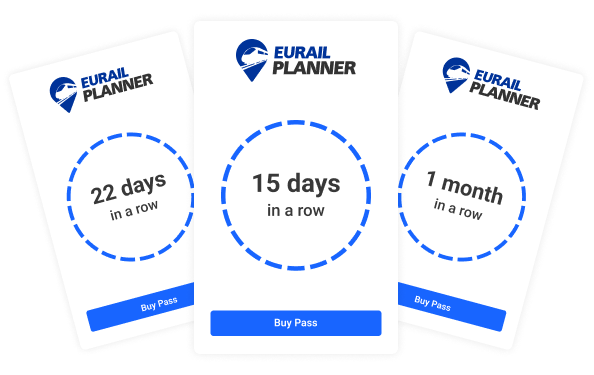
Continuous Global Pass
Unlimited travel across 33 countries for up to 3 months
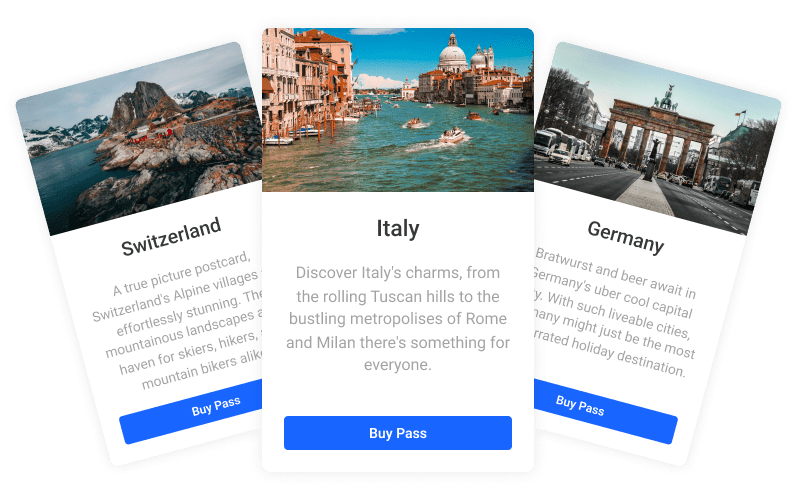
One Country Pass
Delve deeper into one of 30 European countries over 1 month
Ready to plan your Eurail trip?
Get Daily Travel Tips & Deals!
By proceeding, you agree to our Privacy Policy and Terms of Use .

Planning a Trip to Europe: Your 10-Step Guide
Caroline Costello
Caroline Costello's travel accomplishments include surviving a 2 a.m. whitewater rafting excursion in the Canadian wilderness, successfully biking from Dusseldorf to Cologne without a map, and gaining access to a covert pizza speakeasy in New Orleans.
Caroline is an active member of the Society of American Travel Writers (SATW). Her work has appeared on USA Today , the Boston Globe , AOL.com, MSNBC.com, ABC News, TODAY Travel, and CruiseCritic.com, among other publications.
Travel Smarter! Sign up for our free newsletter.
Before you can experience authentic Spanish tapas, piazzas in Rome, or rooftop terraces in Prague, an important to-do list stands between you and your European vacation. The logistics involved in planning a trip to Europe may seem tedious or overwhelming, but the more prepared you are, the greater your chances of a successful trip that lives up to your expectations. That’s why it’s important to do a bang-up job creating an itinerary, arranging transportation, and tackling the brass tacks before you’re off to the Continent.
The following guide explains how to plan a trip to Europe in 10 simple steps—so you can spend less time worrying about your travel arrangements and more time staring at pictures of castles and men in kilts.

1. Get your documents in order.
If you don’t have a passport, it will take at least four to six weeks from the time of application for you to receive one. Expedited services—either through the State Department or an expeditor such as Travel Visa Pro —can trim the process down to a week or so, but it will cost you an additional fee, so it’s best to take care of this well before your trip.
Already have a passport? Check its expiration date. The last thing you need is to find out your passport has expired while you’re in line at airport check-in. Keep in mind that some countries require your passport to be valid for six months beyond your trip dates.
All car rental companies require drivers to have valid licenses in their home country, so you’ll also want to check the expiration date of your license. Some car rental companies also require an international driving permit for European rentals in addition to a valid driver’s license. For U.S. citizens, these can be obtained through the American Auto Association (AAA); in Canada, try the Canadian Automobile Association (CAA).
Depending on length of stay, some destinations require valid visas in addition to passports; obtaining one is a complicated process that can take weeks even after you have been approved—so start early.
2. Establish a budget.
When planning a trip to Europe, establish a budget as early as possible—even before you know your destination, travel dates, or itinerary. Some destinations are generally cheaper than others, but there are ways to save everywhere: travel in the off-season, pick budget accommodations, plan a shorter trip. For example, London is an expensive city, but many travel providers and airlines offer affordable vacation packages to the city, and it’s not hard to find cheap air deals to London, especially during the winter.
Set your budget early on, and you’ll avoid any disappointment that could come from forging a fabulous itinerary, like two weeks in Switzerland during summer, and then discovering you can’t afford it. Travel budget apps such as TrabeePocket ( iOS | Android ) can help you keep track of your expenses once you start making bookings.
The Most Expensive Cities in the World
3. Pick a destination.
Now that you know how much you can spend, where do you want to go? If you’re like many travelers and you have a humongous list of places in Europe you want to visit, this could be tricky.
One strategy is to pick a particular site that’s on your must-see travel list, and plan your vacation around that. Last year I planned a trip to Ireland centered on an excursion to remote Skellig Michael Island , a UNESCO World Heritage site I’d dreamed of visiting. The excursion turned into an unforgettable two-week Emerald Isle road trip.
Another option is to pick someplace timely. Visit countries’ tourism websites and search for seasonal events like festivals or local holidays (which you may want to either avoid or join, depending on how you feel about crowds). Don’t forget to check the weather before you decide on your destination.
4. Create a rough itinerary.
So you want to go to France, eh? Don’t go ahead and buy a roundtrip flight to Paris and a hotel room—at least, not yet. Planning a European vacation takes a lot of prep work. You’ll want to sketch out a day-by-day itinerary of your perfect trip to France before you book a thing. Research sites and cities you really want to explore, and then figure out which ones you have the time and budget to get to.
Check out alternative ways to travel in Europe. If you want to see multiple countries or cities but are on a tight budget, you may want to consider a cruise (exchange rates are naught for U.S. citizens onboard American ships). If you’d rather not do the work of creating your own itinerary, continue booking a group tour with a company such as Intrepid Travel , G Adventures , Trafalgar , or Rick Steves’ Europe .

5. Book your airfare.
Because airfare will probably be the most expensive part of your trip, you’ll want to book it before anything else (car rental, hotel, etc.). This will allow you to be more flexible with your dates, which is a great way to save money on your flight. You can often spend less by flying on international discount airlines like Aer Lingus or Norwegian . Check multiple booking sites , including meta-search sites such as Skyscanner and traditional booking sites such as Expedia , to make sure you’re seeing a wide range of options. You can also set up fare alerts using Airfarewatchdog , SmarterTravel’s sister site, so you’ll be notified when the price of your flight drops.
Consider spicing up your trip with a layover in a different country. Icelandair has a long-running program that allows passengers flying elsewhere in Europe to take a free stopover in Reykjavik for up to seven nights.
Where to Find Premium Airfare Deals on First Class and Business Class
6. Book your accommodations.
It’s time to go back to that rough itinerary you jotted down and fill in some places to sleep. As is the case with pretty much everything you book for your trip, the earlier you make arrangements, the better—especially during summer high season.
Sure, you can just book a room at the local Hilton and be done with it. But do a bit of research and you could discover some funky lodging that’s almost as exciting as the attractions you plan to visit. Keep your eyes open for historic castles, tiny bed and breakfasts, houseboats, eco-friendly hotels, or organic farms. Budget travelers take note: Vacation rentals , homestays, farm stays, and house-swapping are accommodation options that can be shockingly affordable … or even free.
As with airfare, you should shop around on multiple hotel sites to make sure you’re getting the best deal, and read reviews from past guests to see what the experience is like. TripAdvisor , Booking.com , and Hotels.com are a few good places to start.
7. Consider travel insurance.
There are several kinds of travel insurance: trip cancellation insurance, flight cancellation insurance, medical insurance, etc. The best time to buy insurance is right after you put down the major deposits on your trip, whether that entails airfare, a package, or prepaid hotels. Once you know how much money you’ve paid upfront, you can ensure your trip if you so choose. Many airlines and travel providers sell insurance that you can purchase along with your flight or tour package. Always, always read the fine print in your policy and compare it with other travel insurance policies before you make a purchase.
Check your medical insurance coverage to see if you’re covered overseas. If not, you may want to purchase supplemental medical insurance to cover situations like the cost of transportation back home for emergency care.
Reputable travel insurance companies to consider include Allianz Travel and Seven Corners .
Travel Insurance Coverage: 18 Things Your Policy Won’t Cover
8. Book local transportation and day tours.
When in Rome, ride the Metropolitana. Find out how the locals get around the destination to which you’re traveling and act accordingly. You won’t need a car rental in places like bike-friendly Amsterdam or London with its convenient underground Tube, unless you plan to go outside the city.
A car rental is your best bet if you’re traveling to locales that can’t be easily reached by rail or plane (such as the Irish countryside). Be mentally prepared to drive in a foreign country, which can be a frightening experience when faced with incomprehensible traffic signs, narrow streets, or sheep roadblocks.
To get from city to city or country to country, examine your rail options in comparison to routes and prices offered by European discount airlines like easyJet or Ryanair . Travelers embarking on extensive travel within Europe may save money by purchasing a rail pass from Rail Europe that permits unlimited train travel within a specified region.
Check out Viator to book day tours, especially if you want to take advantage of skip-the-line options.
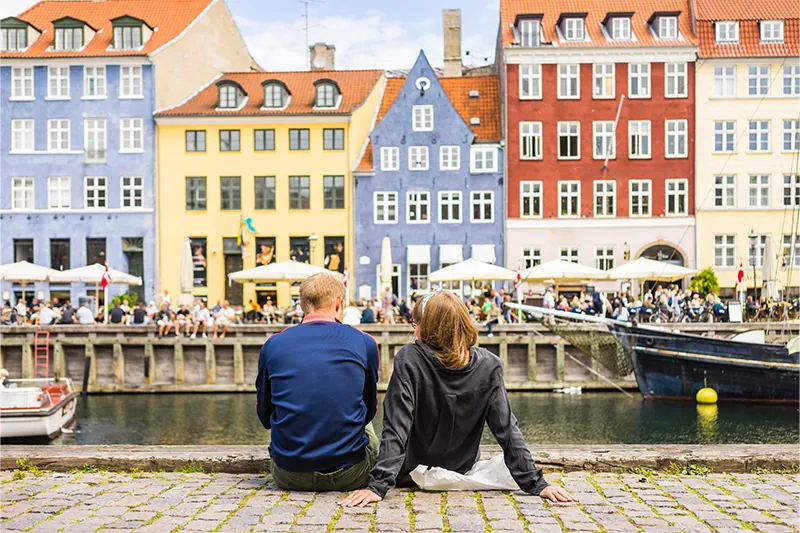
9. Tackle last-minute logistics.
A few weeks before your departure date is the right time to start taking care of a number of key logistics: money, phone, house-sitter, pet-sitter.
Call your credit card companies to let them know you’ll be traveling abroad. While you’re at it, find out if you’re going to be charged a fee for using your card overseas. Research the locations of ATMs in your destination, especially if you’ll be relying on cash.
Does your cell phone plan allow you to make calls overseas, and if so, how much will it cost you? Many cell phone companies offer temporary international plans that you can purchase for the month you’re traveling. You might also want to consider a mobile hotspot device to keep you connected.
5 Ways to Use Your Phone GPS Without Data
Packing for Europe requires both different items and a different mindset in comparison to some other types of trips. After all, there’s no arguing that Parisians are more stylish than your typical North American tourist. Most of central and western Europe have milder climates throughout the year, but that doesn’t mean you won’t encounter rain or a heatwave. You should pack clothing that’s easy to layer , and always include a packable raincoat or travel umbrella in your suitcase when traveling to Europe. Think about how you’ll be carrying your money —pickpocketing schemes are more common abroad, so it’s important to carry your money and personal belongings securely. When researching your European destination of choice, consider the overall climate and time of year you’ll be traveling. Then, about a week before your trip check out the forecast, mobilize a packing list , and ensure your suitcase is in working condition and meets your airline’s size restrictions.
Pro packing tip: If you’re tight on packing space, invest in a packing cube set . They do wonders, especially if you’re stopping in multiple destinations as they make repacking a breeze.
Editor’s note: This story was originally published in 2017. It has been updated to reflect the most current information. All of the products featured in this story were hand-selected by our travel editors. Some of the links featured in this story are affiliate links, and SmarterTravel may collect a commission (at no cost to you) if you shop through them. As an Amazon Associate, we earn from qualifying purchases.
You Might Also Like:
We hand-pick everything we recommend and select items through testing and reviews. Some products are sent to us free of charge with no incentive to offer a favorable review. We offer our unbiased opinions and do not accept compensation to review products. All items are in stock and prices are accurate at the time of publication. If you buy something through our links, we may earn a commission.
Top Fares From

Don't see a fare you like? View all flight deals from your city.
Today's top travel deals.
Brought to you by ShermansTravel
9-Nt Dublin, Cork, Killarney & Galway...
Railbookers

Luxe, 12-Night Spain, France, Monaco &...
Regent Seven Seas Cruises

Ohio: Daily Car Rentals from Cincinnati

Trending on SmarterTravel

Get our Rail Planner app
Plan your trip, get extra discounts, and show your Pass as you go.

Our favorite spring routes
Celebrate spring with these 7 off-the-beaten-path train routes

All about seat reservations
Everything you need to know about booking your seats

Alternatives to Busy Routes
Travel between popular European cities without seat reservations

Through our Chatbot in the bottom right corner.

Ask the Community
Browse questions from fellow Eurail travellers, or ask your own!
- Plan your trip
- Order overview
- Reservations overview
- My Trips & Travelers
- {{translatedTraveler}} {{#promotional}} {{currencySign}} {{standardPrice}} {{/promotional}} {{quantity}}x {{currencySign}} {{finalPrice}}
- Child {{childPasses}}x FREE
- {{translatedPassType}}
- {{translatedValidityPeriodDescription}}
- {{translatedClass}}
- Remove Pass(es)
- {{variant.localizedTravelPackDescription}} {{quantity}}x Free
- {{variant.localizedPassUpgradeDescription}} {{quantity}}x {{currency}} {{price}}
- Your order will arrive by {{expectedDeliveryDate}} 1 x {{currency}} {{price}}
Your cart is empty
Plan your Eurail trip
Want to discover Europe? With Eurail, you can plan your own rail route, choosing from 30,000+ destinations in 33 countries. Take your pick from the countries below and see where you can go with our railway map.
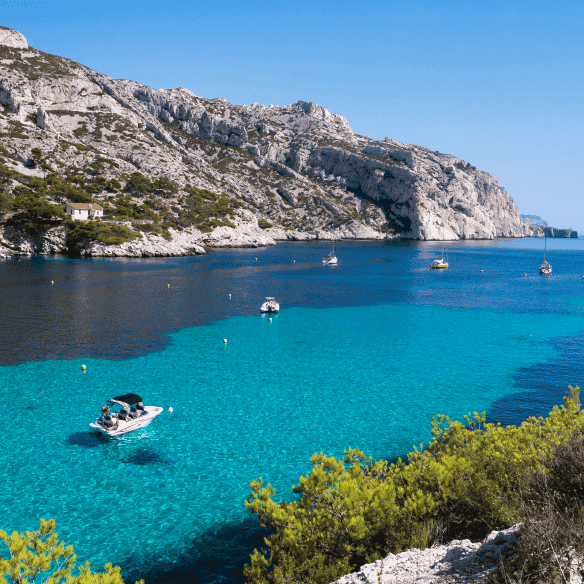
Ready to plan out your route?

Find out which Pass you'll need
Plan your trip using our map and we'll suggest the best matching Eurail Pass.
Download the Rail Planner App
The ultimate Eurail trip planner! Look up train times and plan your route with just one app.
Join our Community
Need help planning your trip? Ask the experts! Find Q&As, itineraries and tips from Eurailers who’ve gone before you.
Change of currency
You cannot change the currency once you have a Pass in your cart. Remove the Pass, and then change the currency on the website header.
Travel blog
Don't Miss A Thing: The Ultimate Three Week Europe Itinerary

7.02min read
Published 7 April 2022

Flight Centre
You’ve got three weeks in the UK and Europe – how are you going to spend them? Three weeks might seem like a long time, but believe us when we say that you could spend a lifetime travelling around this part of the world and there would still be more places to see, food to try and experiences to have.
Luckily, we’re here to help you see as much as possible in the time you’ve got! Here are our top three UK and Europe itineraries to give you some inspiration. Pick your favourite one or stitch them all together to create the ultimate UK and Europe trip. It’s entirely up to you!
Itineraries
- UK and Europe
- Scandinavia

Itinerary One: UK and Europe
Dublin, ireland.
Where better to start your adventure than the friendly city of Dublin ? Visit the Book of Kells at Trinity College Dublin for a dose of history and follow it up with a trip to the Guinness Storehouse . It’s the perfect place to learn all about Ireland’s most iconic beverage!
Edinburgh, Scotland
Next up is Edinburgh , Scotland’s stunning capital! Walk the cobbled Royal Mile, hike Arthur’s Seat or explore Scotland’s intriguing history at Edinburgh Castle and the Palace of Holyroodhouse . The city is full of historic sites to explore. If you’re visiting in August, make sure to check out the famous Edinburgh Festival Fringe.
London, England
Journey south and get ready to immerse yourself in the hustle and bustle of London life. Catch a theatre performance in the West End and explore the many incredible (and often free) world-class museums London has on offer. You’ll also want to visit all the iconic landmarks like Buckingham Palace, Westminster Abbey, St Paul’s Cathedral and Trafalgar Square.
London is home to lots of incredible parks and green spaces that shouldn’t be skipped! Pack a picnic and head to Greenwich Park, Battersea Park, Kensington Gardens or Regent’s Park. You’ll forget you’re in the major, metropolitan city of London.
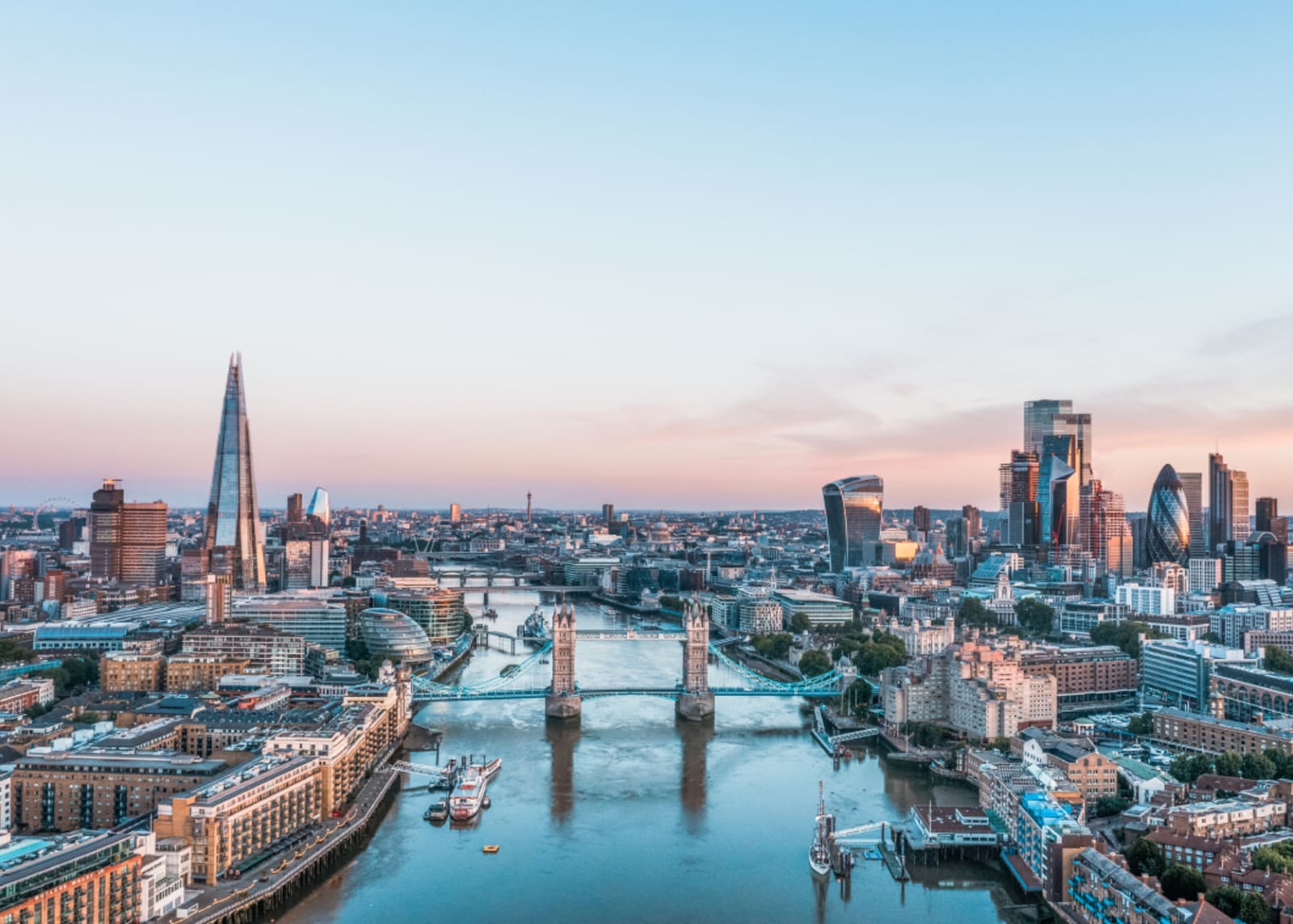
Paris, France
Day 9 to 11.
Wave goodbye to the United Kingdom as you cross the Channel and arrive in Paris . Climb the Eiffel Tower, walk along the Seine and pay a visit to da Vinci’s Mona Lisa at the Louvre . For something different, explore the charming, cobbled streets of the Montmartre district. Oh, and don’t forget to allow plenty of time for bread, cheese and croissants while you’re there!
Amsterdam, the Netherlands
Day 13 to 14.
Next stop, the Netherlands! We’d recommend visiting the Rijksmuseum and the Van Gogh Museum for a bit of culture while in Amsterdam . Or spend some time at the Anne Frank House to learn more about this incredible young girl’s story. Rent a bicycle to explore the city like a local and make time to try some poffertjes, or Dutch pancakes.
Berlin, Germany
Day 15 to 16.
Immerse yourself in history at the East Side Gallery, once part of the Berlin Wall and now a 1.3km long art installation, and the Memorial to the Murdered Jews of Europe. Keen to get outdoors? Pay a visit to Tempelhofer Feld for something different! It’s an abandoned runway-turned-city park. And don’t leave Berlin without sampling some of Europe’s best kebabs.

Prague, the Czech Republic
Day 17 to 18.
From Berlin to Prague ! Lose track of time admiring the famous Prague Astronomical Clock in Old Town Square or take a stroll across the striking Charles Bridge. Prague Castle is another attraction that you won’t want to miss. The castle dates all the way back to the 9th century.
Salzburg, Austria
Day 19 to 20.
Next stop on your Europe itinerary is the charming city of Salzburg . Visit the Getreidegasse, Mozart’s birthplace and now a bustling shopping street, or head to Hohensalzburg Fortress , one of Europe’s largest medieval castles. Fan of the Sound of Music? See the sights of Salzburg made famous by the movie on a guided tour.
Zermatt, Switzerland
Day 20 to 21.
Onwards to the Swiss Alps! Go skiing, take in the views and explore an enchanting glacier palace at the Matterhorn Glacier Paradise , Europe’s highest mountain station. A visit to Zermatlantis, the Matterhorn Museum, is perfect for those looking to find out more about the history of the famous Swiss landmark.
Switzerland is also a great place to experience some of the best train travel in the world! Try the Jungfrau Railway and journey to the highest railway station in Europe. It’s a good idea to book your train tickets in advance. You can also reserve a seat to make sure you get a great view while on board.
UK and Europe Travel: Tips on Where to Visit Based on Your Travel Type
CHECK IT OUT ➜
Itinerary Two: Europe
Barcelona, spain.
Admire the distinct architecture of La Sagrada Familia, Barcelona’s famously unfinished basilica, or the colourful ceramic designs decorating Park Güell . Authentic Spanish paella and tapas are also a must while visiting Barcelona.
Rome, Italy
Hopefully you’ve been practising your Italian because the next stop on our travel itinerary is Rome ! Be transported back to the time of gladiators with a visit to the Colosseum. The Trevi Fountain and the Pantheon are also incredible landmarks that you’ll want to tick off the bucket list.
Spend a full day exploring Vatican City if you can! From the Renaissance architecture of St. Peter’s Basilica to Michelangelo’s incredible painting ceiling in the Sistine Chapel, the world’s smallest city is sure to leave a big impression.
Venice, Italy
The second Italian stop in this Europe itinerary is Venice , the famous ‘floating city’. Known for gondola rides on the Grand Canal, the imposing St. Mark's Basilica and Doge’s Palace, Venice is sure to keep you busy.
Make sure you try the seafood and explore the colourful Burano neighbourhood while you’re there. And if bridges are your thing, don’t miss the Rialto Bridge and the Bridge of Sighs. Both are hundreds of years old and bursting with history!
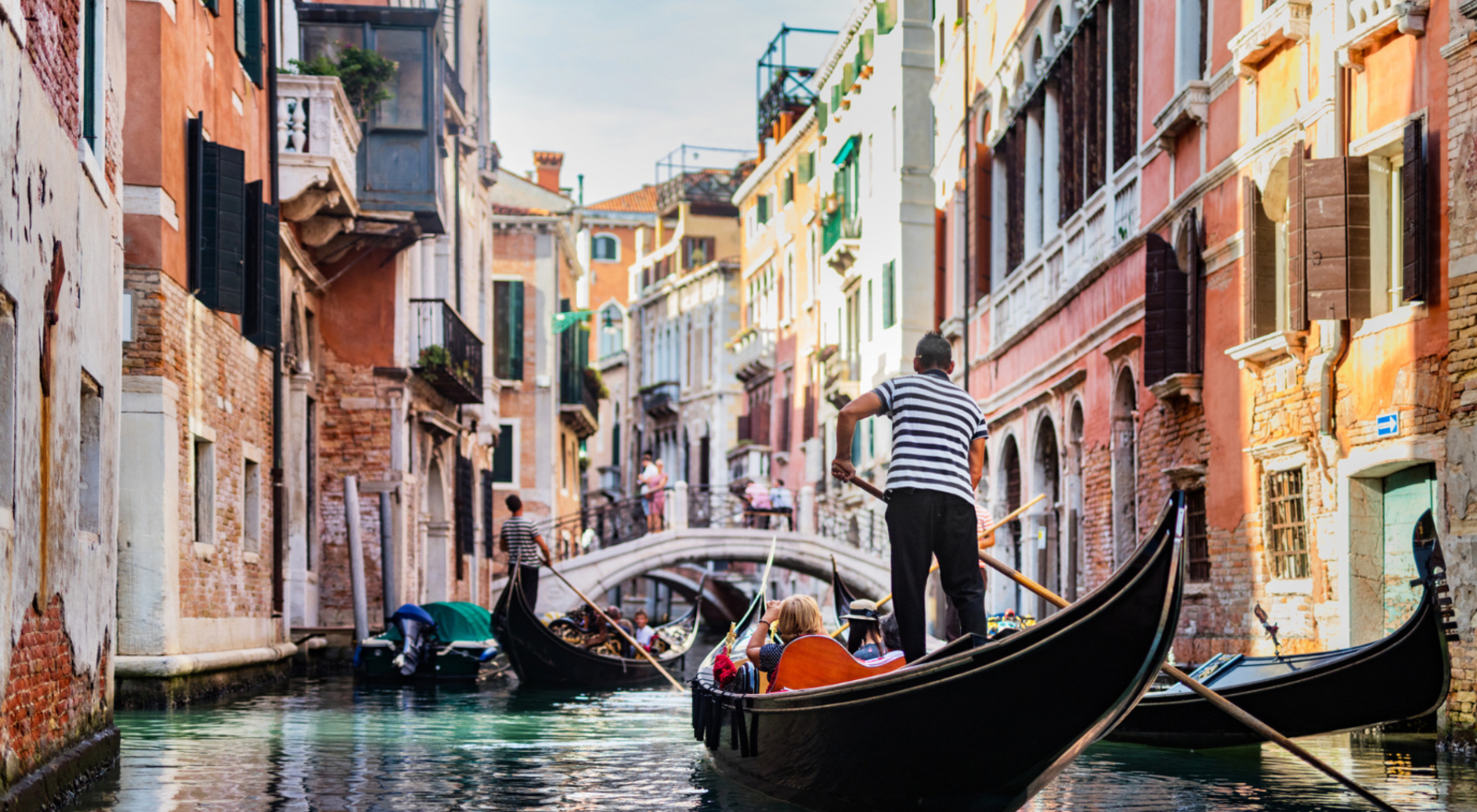
Zagreb, Croatia
Day 10 to 11.
Your adventure continues with a stop in the Croatian capital of Zagreb ! This often-overlooked destination is full of museums, galleries and cultural attractions to explore. Check out King Tomislav Square, a beautiful green space found in the city centre, St. Mark’s Church and the Cathedral of Zagreb. For those looking for quirkier experiences, pay a visit to the Museum of Broken Relationships – an entire museum dedicated to failed romantic relationships!
Budapest, Hungary
Day 12 to 14.
From the imposing Hungarian Parliament Building and Buda Castle to views of the Danube River. Hungary’s major city of Budapest has something for every traveller! Relax and let your worries wash away with a visit to the Széchenyi Thermal Bath or be moved by the Shoes on the Danube Bank memorial honouring the Jews who were killed there during World War Two.
Listed as a UNESCO World Heritage Site, make sure you save some time to wander Budapest’s beautiful streets. Sampling some local delicacies, like Kürtőskalács (a delicious, sweet treat) and goulash, is also highly recommended!
Athens, Greece
Day 15 to 18.
Next up on our three-week Europe itinerary is Athens , the birthplace of modern democracy and Western civilisation. Once one of the world’s most influential cities, Athens is full of ancient monuments to marvel at, like the Parthenon and the Panathenaic Stadium. Don’t miss the National Archaeological Museum and the Acropolis Museum to take in that Greek history before fuelling up on souvlaki, moussaka and gyros!
Travel Tips: How Much Does It Cost To Go To The UK & Europe?
Istanbul, turkey, day 19 to 21.
This adventure ends in Istanbul , a major city in Turkey and well worth a visit! Don't miss the iconic Blue Mosque, also known as the Sultan Ahmed Mosque, Hagia Sophia and the Galata Tower. And no trip to Istanbul would be complete without a wander through the Grand Bazaar, one of the world’s biggest and oldest covered markets! It’s the perfect spot to pick up some unique Turkish souvenirs for your family and friends back home.

Itinerary Three: Scandinavia
Copenhagen, denmark.
Our third itinerary starts further north, in chilly Copenhagen ! Don’t miss Tivoli Gardens , one of the oldest amusement parks in the world, or the famous Little Mermaid statue. Do as the locals do and get around by bicycle, eat in some of the world’s best-hatted restaurants and explore Freetown Christiania, the self-governing community in the heart of the city.
If you want to see Scandinavia a little differently, cruising is a great option! For more information on cruising post-COVID-19, see How Safe Is Cruising Post COVID-19?
Stockholm, Sweden
Next stop, Sweden ! Immerse yourself in culture by exploring the narrow, cobbled streets and impressive historic buildings of Gamla Stan, Stockholm’s Old Town. After you’re done there, head to the Vasa Museum for the chance to admire and learn all about the Vasa, a well-preserved seventeenth-century warship. Museum-lovers might also like to check out ABBA The Museum , Stockholm Medieval Museum and the Viking Museum .
Helsinki, Finland
Time to visit another major Scandinavian city – Helsinki ! Located on the Gulf of Finland in the country’s south, Helsinki is the perfect place to unwind for a day or two.
Explore the vibrant Market Square for traditional food options and unique souvenirs paired with striking views out over the South Harbour. In winter, you’ll find heated café tents waiting to keep you warm while you enjoy your hot chocolate or coffee and soak in the atmosphere! Feeling adventurous? Take a ferry out to the UNESCO World Heritage Listed Suomenlinna Fortress , an eighteenth-century island fortress.
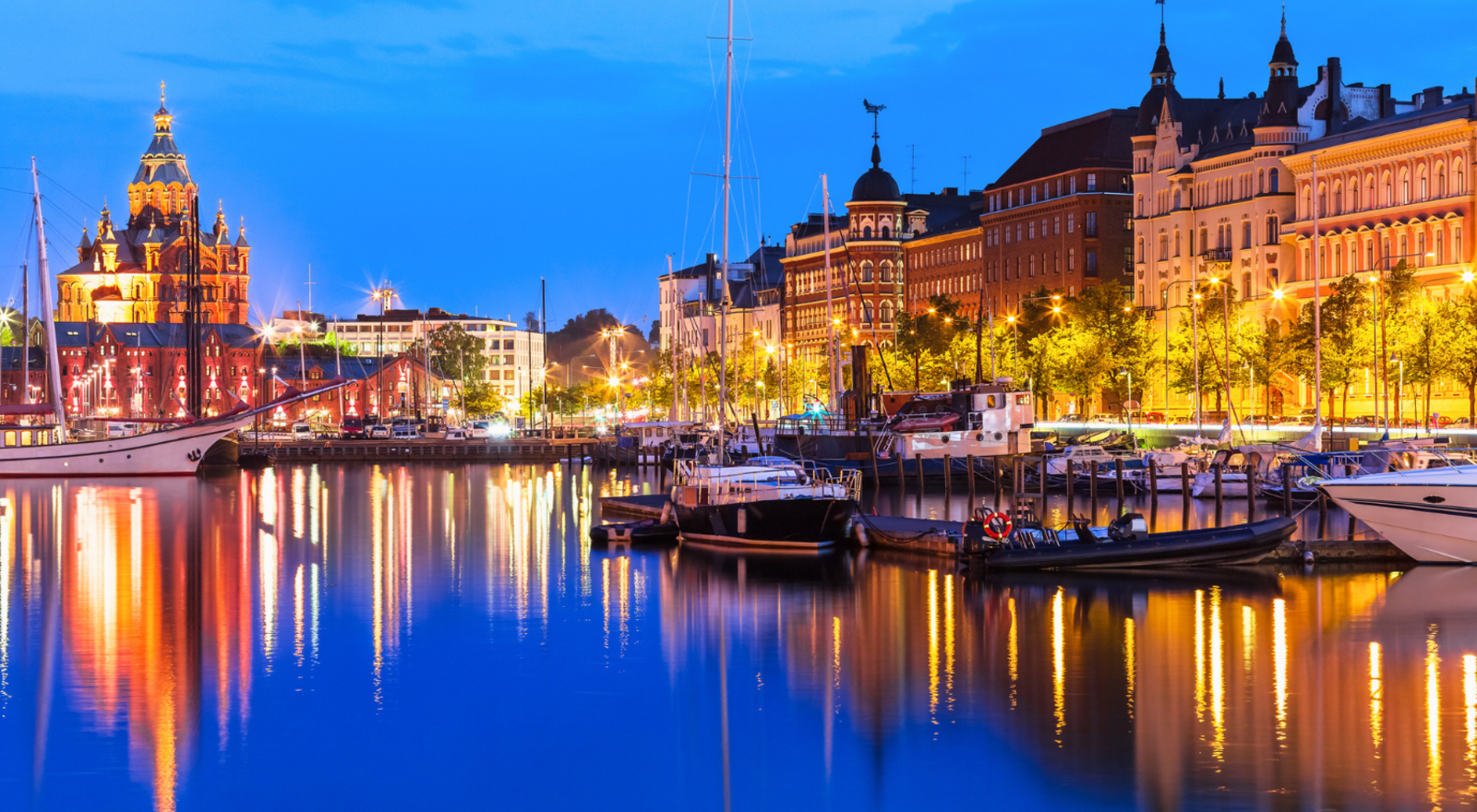
Rovaniemi, Finland
Day 8 to 11.
Onwards and upwards! Rovaniemi , the capital of Lapland , is the next stop on this three-week itinerary. Known as the Official Hometown of Santa Clause, Rovaniemi is the perfect place to get into the Christmas spirit – no matter what time of year you visit!
Spend a full day exploring Santa Clause Village . Meet Santa Clause, hang out with the reindeer and enjoy Christmas-themed Arctic cuisine. And what better time to get started on the Christmas shopping? Oh, and keep your eyes on the skies when the sun goes down in case the northern lights decided to come out and play.
Lofoten Islands, Norway
Looking for something a little more remote? You’ll love this next stop! The natural beauty of the Lofoten Islands dotted along the northern Norwegian coastline is unforgettable. It's also far enough north to experience the midnight sun when visiting in the summer or to search for the northern lights in winter.
Explore small fishing villages, feast on some of the freshest seafood around or brave the arctic waters (wetsuits definitely required) and go surfing. Yes, you read that right!

Oslo, Norway
Time to go to Oslo ! Visit the Bygdøy Peninsula for the city’s best museums (try the Norwegian Maritime Museum , the Norwegian Folk Museum and the Fram Museum ) and incredible hiking trails.
Visit Akershus Castle and Fortress to learn about Oslo’s medieval history. Then, go tobogganing in Korketrekkeren or try Fårikål (lamb and cabbage stew – a Norwegian favourite). No matter how you spend your time here, Oslo is sure to keep you busy!

Reykjavik, Iceland
Day 18 to 21.
The last stop on this epic three-week adventure is the charming city of Reykjavik ! Admire the striking architecture of Hallgrímskirkja church and be sure to check out the famous Sun Voyager sculpture. You’ll also want to make time for a mosey down Laugavegur, Reykjavik’s main shopping street, for souvenirs and a coffee.
There are lots of incredible day trips (or multi-day trips if you have the time) that depart Reykjavik and explore other attractions in Iceland ! Try planning a day trip to the Snaefellsnes Peninsula, Thingvellir National Park, the Blue Lagoon or Geysir.
There are so many ways to enjoy your trip to Europe or the UK . Be inspired by the itineraries above or plan your own travel itinerary. However you choose to spend your weeks in Europe or the UK, you’re sure to make memories that will last a lifetime.
Explore UK and Europe Deals
Find a Consultant
Watch our new YouTube Series - Relax
Site quick links, help & support.

Flight Centre acknowledges the Traditional Custodians of Country throughout Australia.
© Flight Centre Travel Group Limited. ATAS Accreditation No. A10412.
*Travel restrictions & conditions apply. Review any specific conditions stated and our general terms at Terms and Conditions . Prices & taxes are correct as at the date of publication & are subject to availability and change without notice. Prices quoted are on sale until the dates specified unless otherwise stated or sold out prior. Prices are per person.

How to Plan a Europe Trip from Scratch: Step by Step!
*FYI - this post may contain affiliate links, which means we earn a commission at no extra cost to you if you purchase from them. Also, as an Amazon Associate I earn from qualifying purchases. Check out our Privacy Policy and Disclosure. for more info.
If the thought of planning your own trip to Europe makes you want to throw up, keep reading.
Between choosing where to go and finding the best flights, to picking hotels and assembling itineraries, trip planning is not an easy task for the uninitiated.
Luckily, there are pathological planners like myself who thrive on it.
So today, this Type A laptop goblin is going to break down for you step by step how to plan your own Europe trip from start to finish… because at the end of the day, travel (even the planning part) should be fun.
This is going to be a pretty long post, but by the end of it, you should have all the tools and knowledge you need to plan a delightful Europe trip alllll by yourself.
So, let’s get started! No time to lose.
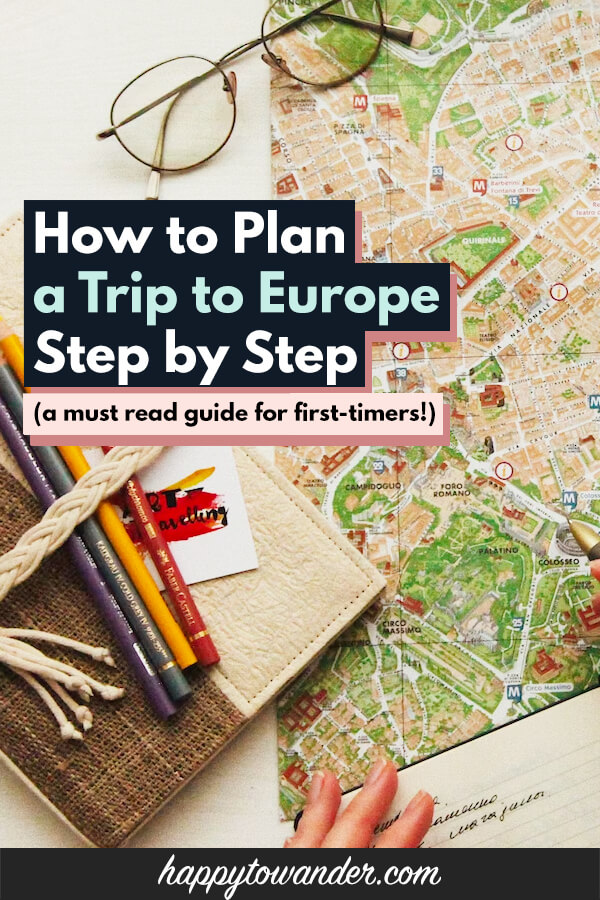
Save this Guide on How to Plan a Trip to Europe for Later!
You’ll be very glad you did.
1. Understand the Schengen Area
Alright let’s start with the very first step of planning your own trip to Europe. Before we get into the topic of visas and entry requirements, we need to talk about something called the Schengen Area.
A lot of people falsely assume that border-free travel exists all throughout Europe, but that’s not actually true.
In reality, the whole ‘travel without borders’ thing only applies to a certain group of countries in Europe known as the Schengen Area, or Schengen Zone, who have all mutually agreed to not impose internal border controls between them.
As of 2023, the countries belonging to the Schengen Area include…
- Liechtenstein
- The Netherlands
- Switzerland
Practically speaking, this just means that if you stay within the Schengen Area (i.e. the countries listed above), you won’t need to clear passport control every time you cross a border. If however you enter a non-Schengen country like the UK or Ireland, then you will need to go through passport control.
NOTE: People often confuse the Schengen Area with the EU, and while there’s a lot of overlap, there’s some EU countries NOT in the Schengen Area and some non-EU countries that ARE in the Schengen Area, so it is different and you shouldn’t get them mixed up.
The reason it’s important to know this distinction is it can impact what visas you might have to apply for, or put a limit on how long your trip can be. So, be sure to keep that in mind.
For most short stay visas (and visa exemptions), your time allowance in the Schengen Area is 90 days out of a 180 day period .
The easiest way to understand this is to imagine yourself on the day that you leave the Schengen Zone to go home or onto your next destination.
From that departure date, you should be able to look back on the past 180 days and say you haven’t been in the Schengen Area for more than 90 days total.
… I know it sounds kind of confusing, but read it a few times over and you’ll get what I mean! Or, for more clarifications and examples, read my full written guide to understanding the Schengen Area’s 90/180 day rule.

2. Decide How Long Your Europe Trip Will Be
Alright, now that you know the difference between Europe, the EU, and the Schengen Area, your next big hurdle is deciding how much time you’ll be spending on your Europe trip.
This answer to this of course depends on a lot of variables, but I’ll say this: my first independent trip around Europe was 6 weeks long, and even that felt like barely enough.
So, if you’re coming from overseas, I would recommend a 10 day minimum because you have to make that jet lag worth it, but if you’re working with less time, I would then just adjust the number of destinations you’re visiting accordingly to ensure you’re not overwhelmed.
My list of 40+ one week in Europe itineraries can help with that!
The decision of how long to spend in Europe is very personal so I’ll leave that for you to ponder until you cry, but here are some factors to consider:
- Vacation days
- Number of destinations you want to cover
- Amount of time you can spend away from home
- Maximum stay restrictions with your passport (e.g. most non-EU passport holders can only spend 90 days within a 180 day period in the Schengen Area)
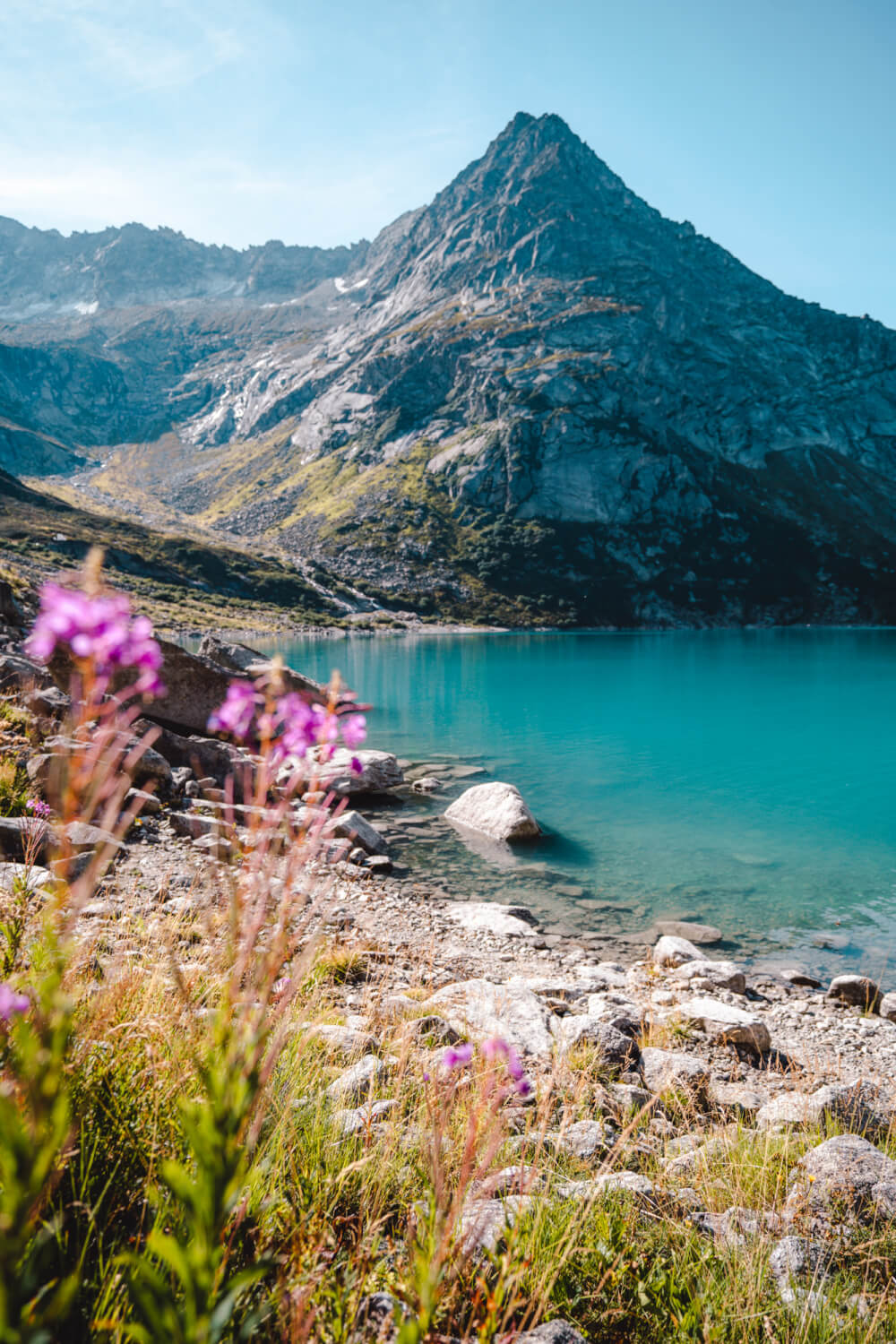
After you’ve figured out how much time you have to play with, we get to…
3. Choose Where You’re Going
Europe may look small on a map, but it’s a vast and varied continent that’s impossible to cover entirely in just one (or even twenty) trips.
A lot of first time visitors to Europe think that they can just land and cover the entire continent in one go like a crazed Energizer Rabbit.
This is 100% what I thought prior to my first European backpacking trip, and let me tell you that my first draft itinerary was loaded with chaos and made zero sense.
While Europe is a lot more compact than Canada or the US, it does still take time to travel between countries and cities, so if you’re dealing with a short amount of time, it doesn’t make sense to cram your itinerary to the point where you’re spending less than a day in a country, or just stopping in for an afternoon.
SO, for shorter trips, what I’d suggest is picking one country or one area and exploring it thoroughly, rather than trying to visit 10 countries in a week.
Again, if you want inspiration, I have this post featuring dozens of one week in Europe itineraries , so feel free to browse that for ideas, but other places to pillage for inspo include…
- Pinterest (search ‘Europe travel’ or specific countries for photos and blog posts to read)
- TikTok (search terms like ‘Europe travel’, ‘[country] hidden gems’, etc.)
- Instagram (browse feeds from travel bloggers to get ideas, scroll through travel-themed hashtags)
- Good old fashioned Google (google ‘places to visit in ____’)

4. Figure Out Visas/Documents
The next step after deciding your destinations is figuring out what visas or documents might you need to enter Europe.
The rules differ depending on the country your passport is from, and also where you’re going, so I can’t give specific advice on this, but if you are one of the 50+ countries who get a visa exemption for the Schengen Zone (including US, Canada, Australia), then you do not need to apply for a visa prior to your arrival.
From 2024 onwards (exact date TBA), it has been announced that those from visa-exempt countries WILL need to apply for a travel pre-authorization through the ETIAS which is very quick to do online and costs a small fee, but that’s not the same as applying for a visa, which is usually a much more time consuming and costlier process.
NOTE: I will update this post when the ETIAS is officially launched, but be sure to consult the website linked above to make sure you don’t need to do it before your trip.
Of course, it goes without saying that the best resource for finding out which visas you need for your Europe trip is your own government’s official website , so be sure to get info from an official source and not a third party that’s simply trying to sell you their visa services.
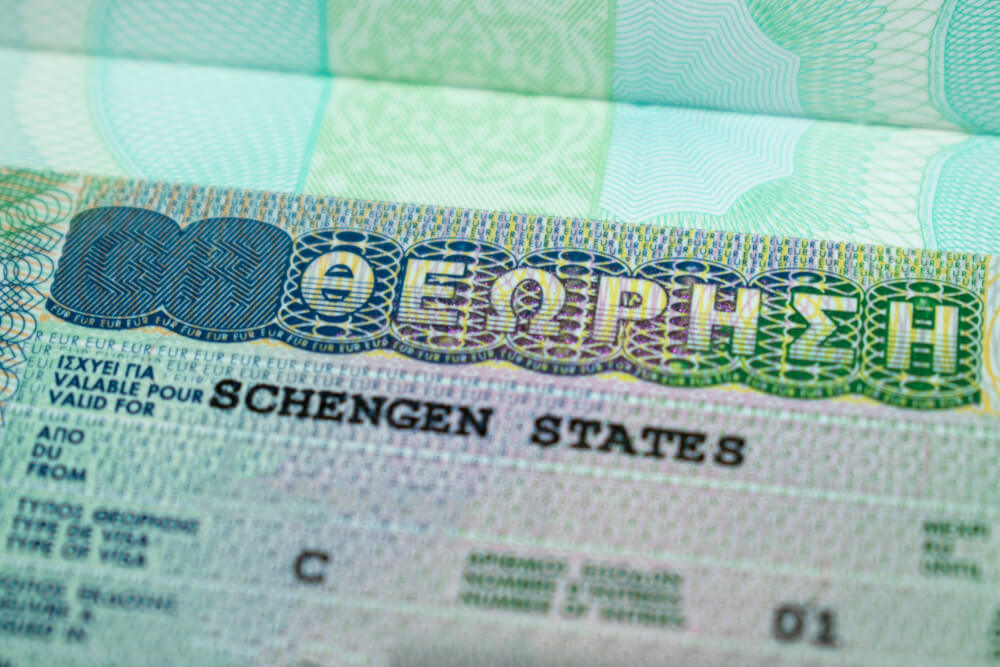
5, Book Your Flights to Europe
With the tough decisions out of the way, the next step in planning your Europe trip is to book flights.
If you want to secure the best deal flying to Europe, I’ve written this extensive guide on How to Find Cheap Flights to Europe , but here’s a quick step by step on how I’d book my flights:
- Hop onto Google Flights
- Enter your departure airport and destination (if you have a specific one in mind). If not, type “Europe” as the destination and it will show you flights across the continent
- Enter specific dates if you have them, or a rough estimate if you’re flexible, then hit ‘Explore’
- Once you’re on the map view, you can see your options, but you can also click on the dates, then hit the ‘Flexible Dates’ tab and choose your parameters (e.g. 1 week trip in the next 6 months) and hit Done to find the best deals
- Scroll your list of options and if you see one you like, click “See Flights” and from here you can also click the Date Grid that shows you if it’s possibly cheaper to fly out on other dates near that
Then repeat this process until you’ve found a destination or some dates that you like.
After you choose your flight, I would always advise booking directly with the airline because this usually ensures you have the best customer support if anything goes wrong.

A QUICK TIP RE: CREDIT CARDS – A lot of people find travel hacking, or credit cards quite overwhelming but I would say if you’re not into travel credit cards at the moment, now would be the time to start if you’re planning a big trip, just because you are going to be spending a lot of money, so you might as well try to reap as many rewards from it as possible. It isn’t for everyone, but I do have great things to say about the Amex Platinum , which has a really high fee but at least for the first year it’s super worth it because you get travel credits, you get travel insurance, lounge access, and most importantly, enough bonus sign-up points to get you a roundtrip flight to Europe from North America. There’s also a bunch more affordable options, but overall, I’d say it’s smart to look into a travel credit card so you can really milk the benefits you get from all the money you’re about to spend on flights, and hotels. One thing I also do because none of my friends really collect points is I’ll offer to book for everyone, and then they pay me back, which is amazing because I get all the points without needing to spend all the money.

6. Book Your Accommodation
Alright, after booking your flights, it’s time to decide where to rest your head after a face-numbing day of sightseeing.
This the general process I follow for finding accommodation:
- Decide if my priority is price, location or hotel quality, then set the max budget for my stay
- Hop on aggregators like Google Hotels or Booking.com to see what the options are, usually using the Map view to select places in central locations, making a shortlist of places as I go
- Pick my top favourites from the shortlist and read through their Google reviews before choosing one
- Book directly with the hotel to potentially get a discount or additional perks
If you’re new to booking accommodation yourself, here is a quick-ish rundown of the most common options.
Overall, from cheapest to most expensive, your accommodation options are..
- Guesthouses
And vacation rentals like Vrbo and Airbnb are kind of an awkward in between.
One important thing to keep in mind though is this:
Price, Location, Hotel Quality – you can really only pick two.
- If it’s a good location, and good quality, it’ll be expensive
- If it’s a good price and location, the room will likely not be the best
- If it’s a good price and good quality, you’ll probably won’t be as close to the centre as you want
For me personally, location is often the most important consideration. Because European cities tend to be a lot more walkable than in North America, you want a hotel that you can easily get to from all the sights, rather than have to rely on taxis or trying to a rent a car.
But how do you pick where to stay or what kind of accommodation is best for you?

Option A: Hostels
It’s one of the oldest backpacking tips in the history of backpacking, but if you’re doing your Europe trip on a budget, no doubt hostels are a great option.
Because backpacking culture is so pervasive there, there are a lot of really great hostels pretty much across the continent offering shared dorms for less than twenty bucks a night or even private rooms for additional cost.
For me personally, hostels also have social benefits in addition to budget-related ones, so I’d say don’t knock it until you’ve tried it.
When I was younger, I thought it was so much fun staying at hostels, meeting people from around the world, and making new friends. If this interests you, check out my guide on How to Book Hostels for Beginners.
But hey, I can concede that hostels aren’t for everybody so, if you’re on a budget, but would rather skip the hostel route, then another great option is guesthouses.

Option B: Guesthouses
Guesthouses have different names depending on which country you’re in.
In Germany for instance they’re known as “ Pensionen “, in Italy they’re Pensione (or Pension, in the singular form), but overall you can view them as smaller, homier hotels with only a handful of rooms.
These tend to be a lot cozier than a traditional hotel and usually a lot more modest in terms of furnishings, but they’re also much more affordable, making them an ideal middle ground between hostels and guesthouses.

Option C: Hotels
But of course, for a lot of first time travellers, hotels are firmly in the comfort zone and probably the go-to pick, with familiar amenities like a check in desk, hotel breakfast, etc.
One really important thing to keep in mind if you’re planning on staying at hotels is that, hotels in Europe use a different star system than in North America.
Whereas in North America, how many stars you have kind of corresponds to the overall quality of the accommodation, in Europe it’s more to do with a checklist of amenities, so most five star places will simply be the BIG ones with a pool, a concierge and lots of different perks.
In contrast, there are some decent one or two star properties that are actually quite nice, but they just don’t have those checklist amenities so their star rating is comparatively lower.
So, keep that in mind when you’re browsing because stars here don’t necessarily indicate quality or luxury as much as the North American star system does.

In terms of choosing hotels, you’ll be choosing between…
- Chain properties (e.g. your Hiltons and your Marriotts)
- Independent hotels
Personally, these days, I’m more inclined to pick independent boutique hotels where I can (as these tend to be more unique), but I admit there’s a lot of reliability when it comes to chains, and if you’re someone that collects points and status, it can of course pay to stay loyal.
Boutique properties vary from city to city, so I won’t discuss them too much in-depth here. Just know that if there’s a place I’ve stayed at that I really enjoyed I’ll always link to it in my travel guides!
But for chain hotels in Europe, I think it’s helpful to include a rundown of budget-friendly European chains I recommend that might be new to you if you’re coming from overseas:
Of course, all over Europe, there’s also the standard North American chains that you’re probably already familiar with, as well as bigger mid-range to luxury chains that I didn’t cover above.
If you decide to book with chain properties, one important tip is to make sure you’re signed up for the chain’s Membership program, because then you get special perks and can rack up points, especially if you make a conscious effort to stick with the same chains throughout your trip.

Option D: Vacation Rentals
Now onto the last option which is vacation rentals like Airbnb and Vrbo.
I used to be a huge fan of renting on Airbnb, because it was a pretty budget-friendly option and you could save money too by cooking if you needed to, etc.
But these days, with extreme fees, and the audacity of hosts, I don’t actually think it’s the best option anymore, especially for shorter stays.
Airbnbs can come with a lot of additional mental labour, like you need to vet reviews, correspond with your host, set a check in time, usually you’ll be asked to do certain chores, and you need to make sure you keep the place in good condition, etc.
This might be fine for a longer term situation like if you’re staying for several weeks, but it’s really not worth it if you’re moving places every few days.
Overall, if you want convenience and ease of mind, Airbnb is probably not for you… unless you are a huge group or you want a homey space where you can settle down for a longer period and cook your own meals, etc.
In that case, check out my guide on How to Book an Airbnb (for First Timers).
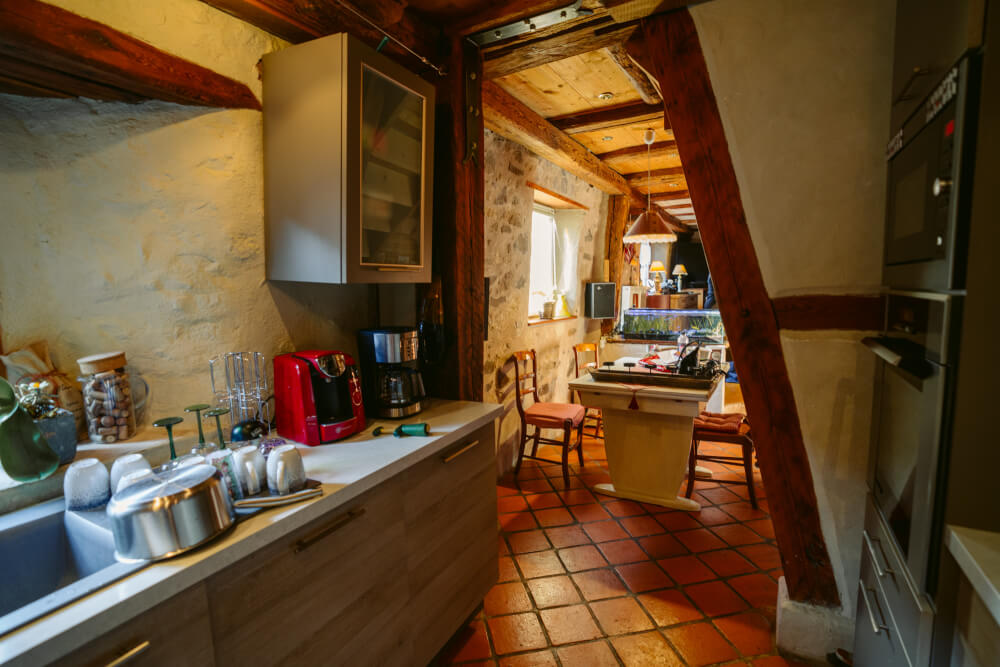
7. Choose How You’ll Get Around Europe
Alright, now with your flights and hotels booked, it’s time to decide how to get from place to place!
First off – I’d say try your best to avoid renting a car.
If you’re doing city trips, odds are you won’t need it and public transport in most European destinations is fantastic. If you’re still undecided, be sure to read my article about considerations to make before renting a car in Europe.
If you have decided to go with purely public transport though (yay you!), my first move is I usually hop on Omio to quickly compare the prices of flights, trains and buses going from Point A to Point B. It sorts everything by cheapest, recommended, shortest, etc. and is totally free!
Be mindful of course though that just like with hotels, there’s always that trade-off when it comes to booking transport.
Speed, Budget, and Quality – you can only choose two.

If you want to learn more about transport around Europe, I’ve written this extensive guide on The Cheapest Ways to Travel Europe , but let’s quickly run through the options from cheapest to most expensive, and their pros and cons.
Overall though, your ultimate defense against crazy costs is to just book as far ahead as possible, because bus, train and plane tickets usually get pricier the fewer seats they have.

8. Find Fun Things to Do While You’re There
If you’ve gotten this far, I think it’s pretty clear… I’m a planner, and I really like knowing what there is to do in a place before I get there so I can maximize my time.
I think it’s important to at least have SOME research done beforehand, because otherwise you waste time in the destination trying to figure it out when you could be using that time to eat spaghetti, you know.

So here’s how I find fun things to do wherever I go :
- 1) Hop on Google. Skim through the top blogs and listicles to get a sense of the top attractions and the most well-known things to do.
- 2) Head to Atlas Obscura, a really cool website that highlights unusual things to do in a place.
- 3) Hop on social media, like TikTok (a great tool compared to Instagram, especially for food and drink spots).
- 4) Look on local blogs, especially event and news ones because then you can see if there’s any cool pop-ups or special events happening during your trip
Throughout this research process, I’ll usually star places I like on Google Maps instead of just making a list.
This is because I can then easily group together all the spots I want to check out by neighbourhood so I can better organize my itinerary.
Of course, as an easy shortcut, you can also google “Destination” itinerary as well and a travel blogger like me has probably shared one.

9. Choose What to Pack
Alright, onto the final hurdle: deciding what to pack.
First of all – breathe . Packing for Europe isn’t too different from packing for other destinations. Contrary to popular belief, not every single European struts the streets like a runway, eager to judge poorly dressed tourists.
Naturally, what to pack depends on the season and where you’re going. You can check out my generic packing lists for Europe in Winter and Europe in Summer for inspo, BUT I do have a few general tips…
- Travel carry-on only if possible – navigating cobblestoned streets and old Metro systems with a ton of luggage is a nightmare. My guide on How to Pack Light can help with that, but in general when travelling carry-on only, I just pack a week’s worth of clothes and for longer trips, I do laundry along the way.
- Use packing cubes – I’m so obsessed with these. They really help keep everything tidy and organized!
- Avoid packing things like athleisure and sweatpants unless they’re just for sleeping in – While Europeans aren’t mega fashionistas all the time, their baseline casual is very different to North America’s – think clean basics rather than athletic wear.
- Good shoes are everything – you’ll inevitably be walking a lot, so prioritize comfort above all else!
Apart from that, I think packing is a really personal thing and mainly you should just wear what’s comfortable… apart from athleisure. That’s definitely not as common here, and I say this as the most die-hard Vancouver Lululemon girly.

My Europe Trip Planning Workbook
Well, if you’ve made it this far, frankly you deserve a medal… and a treat! So here it is. I’ve created a pretty little Europe trip planning workbook that follows the steps outlined above. Hopefully it well help you plan your dream Europe trip quickly and easily!
You can take a look here and print the pages for personal use, or click here for a digital version that can be filled out from your computer:
Hope This Step by Step Guide to Planning a Europe Trip Was Helpful!
So there you have it, from start to finish, how to plan your own trip to Europe.
I hope that was helpful and feel free to ask in the comments if you have any more questions. Safe travels, and I hope you have an amazing trip!
My Go-To Travel Favourites:
🧳 Eagle Creek: My favourite packing cubes
💳 Wise: For FREE travel friendly credit cards
🍯 Airalo: My go-to eSIM
🏨 Booking.com: For searching hotels
📷 Sony A7IV: My (amazing) camera
✈️ Google Flights : For finding flight deals
🌎 WorldNomads: For travel insurance
🎉 GetYourGuide: For booking activities
Leave a Comment Cancel reply
By using this form you agree with the storage and handling of your data by this website. *
The Ultimate Trip Planner
Plan & book your dream trip, routeperfect. with you every step of the way.
Free travel perks only for RoutePerfect members who booked flights, hotels and services through the RoutePerfect site.

How it works

Popular itineraries

Testimonials

RoutePerfect uses cookies to improve our content and provide you with a personalized experience. By clicking "Accept All Cookies", you agree to the storing of cookies on your device to enhance site navigation, analyze site usage and assist in our marketing efforts. Learn more

2 Weeks in Europe: 6 Itineraries
DISCLAIMER: This post might have links to travel services and products that we enjoy. We might make a commission from it at no extra cost to you.
Europe is a continent consisting of 44 countries with diverse languages, climates, and cultures . It has numerous world-famous landmarks preserved from years upon years of history.
Spending 2 weeks in Europe will cover plenty of amazing places. It’s not much, but a good start, especially if it’s your first time here.bulga
Another great thing about Europe is that the places are close to each other, you can reach most of them via train, buses, and driving. Land borders separate the countries. However, many of them practice free movement across borders.
This continent has peninsulas, islands, and varied landforms, as well as seas, lakes, and other bodies of water. There are infinite fascinating places to see, foods to taste, and activities to try out during your 2 weeks in Europe.
TIP : This is a long-form article, I highly recommend you check the Table of Contents below to help you navigate the page easier and faster.
THINGS TO KNOW BEFORE VISITING EUROPE
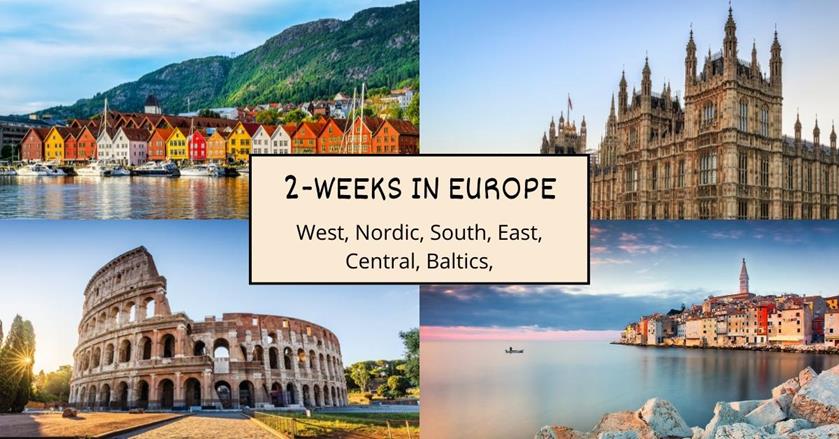
Before you go book your flight and hotels, take a look at the information below first. It will help you visualise and plan your itinerary better. You can get ideas on when to go, how to travel around, and what to pack.
When is the best time to go to Europe
This depends on what you plan to do. Most people go to Europe during summer, but of course, if you want to ski, come between December and February. I personally love going in spring and summer, during autumn, it’s also very pretty but it rains a lot.
You might want to consider travelling during the off-season because this is when there are fewer travellers and the prices of accommodations and tours aren’t sky-high so you’ll be able to save quite a bit.
Getting around Europe
The best way to get around Europe is to rent a car especially if the country you’re visiting are next to each other or have an open border agreement. It’s cheaper and gives you freedom of your time.
However, if you are crossing countries and they are not next to each other, you are probably better off flying than doing a long drive. Check first if your driver’s license is valid in Europe and check what type of cars each country you are going to have.
For example, Italy, Spain, and France are known for using a stick or manual transmission. While the UK and Ireland drive on the left.
Buses and trains are quite reliable and affordable. But there are also domestic flights which are affordable as long as you don’t pack too much unless you are willing to pay extra.
Language and currency
There are over 24 official languages in Europe. You should be able to get around with English but it’s important to also learn basic words to show respect for each country’s culture and easily communicate with locals.
Luckily though, most countries in Europe use Euro, except in the UK, Nordic countries, and maybe some countries in East Europe. It’s easy to pay with credit cards but carrying cash with you for emergencies is still advisable.
Visa and COVID-19 policy
Each country has different visa rules, however, if your destination is an EU member, they have the same visa policy; 90 days visa-free for visitors with a passport from North America, some Latin America, some Southeast Asia and East Asia, and most Oceania. This also applies to non-EU countries such as Switzerland and Norway.
For visitors with a passport from the EU or a European country, you should have freedom of movement for unlimited time except for some nationalities such as the UK and countries in East Europe.
Europe is open to COVID-1 vaccinated tourists. If you are unvaccinated, best to check if your destination has extra entry requirements. Depending on the airline and destination, you might be required to submit a test before boarding.
Wearing a mask is no longer required in many places in Europe, but it’s smart to carry one just in case you get to countries that still require them. Read about the EU reopening .
What is the average cost for 2 weeks in Europe
As diverse as the European culture is, the cost also varies a lot. The budget for 14 days in Europe depends on a few things such as the countries, type of tours, accommodation, and how you plan to move around.
$800 in Eastern Europe will not work for Scandinavia. $800 is a tight budget, but it might work for more affordable countries such as Eastern Europe or the Baltics (assuming this excludes the flights to the region and back). $1,000 will be fine for southern-east Europe, and $1,500 will be decent for central Europe. While west Europe and the Nordics plan to spend around $3,000.
The accommodation will cost the most expensive, but the food can be budgeted. Then the transportation. You can either use public transport or rent a push bike when moving around the cities. Take the bus or train when travelling to the next country or ride a plane.
Travelling during the peak season will also cost a lot more. Check under each itinerary to see the average cost of a 2-week trip in Europe.
Other basic travel tips
Planning a trip can be exhausting and often overwhelming. To make it a bit easier, I use travel sites and services that have flexible cancellation policies in case I change my mind or my travel dates. Here’s a list of travel tools I use. From flight selections, affordable hotels, wide-range options for car rentals, and even affordable travel insurance.
TOP PLACES IN EUROPE (pinned map)
Click the icon on the top right to enlarge the map. Credit: map data: Google
2 WEEKS IN EUROPE ITINERARIES
I will show your six itinerary options to choose from for your 14 days in Europe. Covering multiple countries and featuring famous attractions that are historical, cultural, and outdoor activities.
Deciding where to spend your 2 weeks in Europe can be hard. Should it be in Spain or Portugal? How about both? Should you visit Rome or Paris ? When unsure, there are a few things you can do to see which places are more suitable for you.
For example, Rome would be ideal if you love historical sites such as ruins. Perhaps you like history, but in the form of art, then Paris is the one. For food lovers, don’t miss visiting France, Spain, Italy, and Greece.
Itinerary #1 South Europe: Spain and France or France and Italy
We have two sub-options in our first itinerary for your 2 weeks in Europe. This includes either Spain and France or France and Italy. Spain is well-known for its lively culture, flamenco, arts, and literature, as well as its wines, beaches, and, of course, football.
If you feel like this itinerary is a little too expensive, you can instead go to Portugal. Take a look at how to spend 2 weeks in Portuga l or even just a few days in Lisbon. Spending 14 days in Southern Europe is a good place to do your first trip to this continent.
France, on the other hand, is well-known for macarons, wine, champagne, great pastries, as well as fashion, museums, and other historical sites. You could also do many water activities in France or if you plan to come during winter, you can head to the Alps for some skiing.
Italy is loved for its opera, its art cities, unique scenery, and good food. They are also among the four fashion capitals, with luxury brands, and of course, who could forget the Vespa?
If you have never been to Italy, make sure you visit Venice, Rome, Florence, and the southwest coast, where you can visit Naples for Amalfi and Sorrento. You can also consider 2 weeks in Greece for this itinerary. Not to mention, the south is a famous region to spend honeymoon in Europe .
Spain for 7 days
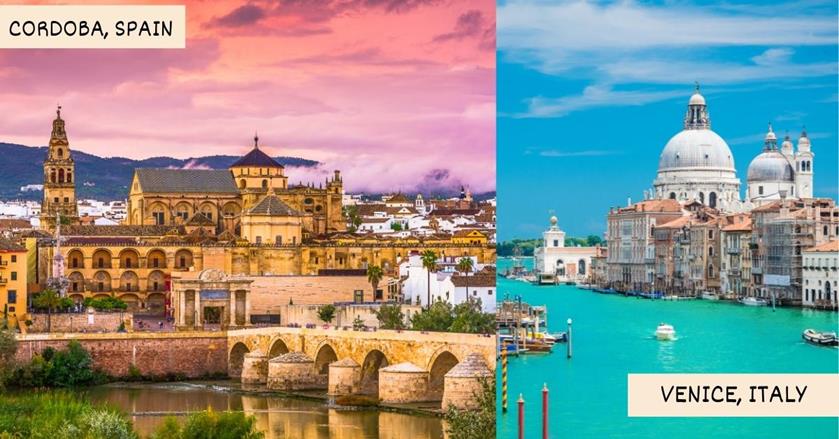
Spain is one of the most popular destinations in Europe, not only for foreign visitors but also for other European nations. With its stunning beaches, yummy food, and very welcoming culture, Spain is undeniably a must-visit when you come to Europe for 2 weeks.
Most people go to Madrid, the capital of Barcelona, a coastal city. However, if you want to get away from big crowds, head to Seville, Valencia, or even Zaragoza. For young travellers who love to dance and party, Ibiza is a top spot, while Palma, Tenerife, and Gran Canaria are awesome islands to explore and spend your vacation in.
We have a specific 2 weeks in Spain itinerary , which might help you plan a trip there if you decide to spend your trip in one European country only.
Here are some of the top-rated attractions in Spain :
- Alhambra and Generalife in Granada
- Palacio Real in Madrid – get your ticket in advance
- El Escorial near Madrid
- Aqueduct of Segovia – north of Madrid
- Sagrada Familia and Gaudi Sites in Barcelona – check tour prices
- Great Mosque in Cordoba, near Seville
- Guggenheim Museum in Bilbao
- Beaches of Gran Canaria
France for 7 days
Some of the options to reach France from Spain include flying, taking a train, riding the bus, using rideshare or driving. The most recommended option is to ride a plane, but if you have plenty of time, you should consider renting a car and driving on your own. We have an article with 3 different itineraries on how to spend 2 weeks in France .
France is a country famous for many reasons. The food is great, it is rich in culture, the abundance of historical sites, and thousands of wineries to explore. France is also known for Tour de France and is a great holiday destination any time of the year. You should geat a hop-on hop-off bu s that will take you to the top attractions of Paris.
Paris is an obvious place to visit, but if you don’t like big cities or have been here before, you can consider other places. For history buffs, head to Calais, Dunkirk, and Normandy. For those who love the outdoors, check out Lyon, Marseille, Nice, and Bordeaux (aka the Basque region).
Here are some of the top attractions n France:
- The Louvre in Paris – book a guided tour
- Cathédrale Notre-Dame de Chartres near Paris
- Eiffel Tower in Paris – get your skip-the-line ticket in advance
- Chateau de Versailles in Paris – visit with a garden access
- Mont Saint Michel
- Loire Valley Chateaux
- Côte d’Azur aka French Riviera in the South
- Provence for lavender fields
- Chamonix-Mont-Blanc for skiing in the Alps
Italy for 7 days
To reach Italy from France, you could either take the train or fly but taking the train is preferred by most tourists and locals alike because you’ll be able to reach your destination in less than five hours anyway. There are tons of routes to choose from if you want to see some interesting scenery and plan to drive instead.
2 weeks in Europe have to include Italy. It is loved for its dishes to die for, beautiful castles, amazing hiking trails, and warm culture. Just like in Spain and France, wine in Italy is world-class and their historical sites are well preserved.
Before you book anything, decide where you want to go. Rome and Venice are the top places to visit in Italy. But if you have been there, it’s time to explore Florence, Milan, Bologna, and Genoa in the north. For the south, head to Naples, Sicily, and all the way to Palermo. Check out our 4 itineraries for 2 weeks in Italy .
Some of the top tourist attractions in Italy include :
- Colosseum in Rome – get your ticket in advance to skip the very long queue
- Spanish Steps in Rome
- Trevi Fountain in Rome
- Venice Grand Canal – don’t skip the romantic gondola ride
- Gode Palace and St. Mark’s Basilica in Venice – explore with a tour guide and secure a ticket
- Leaning Tower of Pisa
- Vatican City near Rome; Basilica of St. Peter, Sistine Chapel & Vatican Museums – you can visit this in one go
- The Uffizi Gallery in Florence
- Cathedral of Santa Maria del Fiore in Florence
- Lake Como near Milan
- Cinque Terre
- Amalfi Coast
- Pompeii and Mount Vesuvius in Naples – visit this and the entirety of Naples on a day trip from Rome
Travel cost
These three destinations are one of the most expensive places in Europe. Budget around $2,000 for a 2-week trip around Spain, France, and Italy not including the flights from your location and back. Accommodation will be the most expensive cost while food is quite affordable in these places.
Of course, if you want to travel with luxury, you can easily spend $3,000-$5,000 which will allow you to stay at 4-5 star hotels, dine at fancy restaurants, and take a private car with a driver anywhere.
For those on a tight budget, $1,500 is possible , however, you will likely stay at youth hostels and share a room with other people in dorm/bunk rooms or even look at Couchsurfing. You can also save more money by looking at ready-to-eat meals at grocery stores or cooking in the hostel is possible. Join a free walking tour where you will be expected to give a tip based on the tour guide and the tour itself.
Itinerary #2 Central Europe: Germany and Poland
For this next itinerary, we’ll be covering 2 weeks in Central Europe, which consists of the countries Germany, Poland, Switzerland, Liechtenstein, Austria, Czechia, Slovakia, and Hungary. However, in this itinerary, we’ll only be covering Germany and Poland.
Germany is well-known for its cathedrals, castles, palaces, and colourful architecture, as well as its sausages and beers. It has many historical sites relating to World War I and II. Berlin is loved for being vegan-friendly, but meat-eaters shouldn’t have a problem finding their way around restaurants either.
Conversely, Poland is famous for its food, stunning geography, folklore, history, and friendly locals. In Poland, you’ll find Europe’s most ancient forest, Medieval Castle, the infamous Auschwitz-Birkenau Camp, amazing museums, and more.
Apart from that, you can also visit theme parks in Poland, such as Engerylandia Theme Park, Rabkoland, and Aquapark Sopot.

Germany for 8 days
Germany has so many things to offer that it would take 8 days to satiate your curiosity, and even then, you would barely scratch the surface. Don’t overwhelm yourself trying to see everything in 8 days. If you want t visit Germany only, we have these 2 weeks in Germany itineraries .
Most people will go to Berlin or Munich, but there are also other cities such as Hamburg, Frankfurt, Nuremberg and Cologne to name a few. I highly recommend you rent a car to move around easier, but taking a domestic flight or the train is also easy and affordable.
If you’re going to Berlin, the best way to see all the top attractions is by buying a hop-on hop-off bus with live a tour guide .
Here’s a list of the top attractions in Germany:
- Brandenburg Gate in Berlin
- Berlin Wall
- Cruise the River Spree – book a 2.5-hour boat tour
- Museum Island in Berlin
- Sachsenhausen Memorial – visit with a tour guide
- Neuschwanstein Castle near Munich
- Linderhof Palace near Munich – book a combo tour with Neuschwanstein Castle
- Marienplatz in Munich
- Pay respects at Dachau Concentration Camp – join a tour from Munich
- Kölner Dom in Cologne
- The Black Forest, Baden-Württemberg, near Stuttgart
- Miniatur Wunderland at Port of Hamburg
- Bamberg and the Bürgerstadt near Nuremberg
Poland for 8 days
There are tons of modes of transportation from Germany to Poland, including boarding a plane, using rideshare cars, trains, buses, or driving. Flights between these two countries are frequent and affordable.
Poland has a dark history, but the country is more than that. It has stunning lakes, UNESCO sites, and rather interesting cuisine, and it is in the top 20 safest countries in the world – a great place to discover if you are travelling alone.
Poland also has the biggest castle in the world, and many believe that vodka originated in Poland. In winter, you can ski in Poland, which is more affordable than France, Switzerland, and even Italy.
Many foreigners get confused and think Krakow is the capital of Piland, but it’s actually Warsaw. Apart from these two cities, you can also visit Gdansk, Wroclaw, Katowice, and Lublin. Most of the cities are connected via buses and trains hence moving around during your 2 weeks in Europe shouldn’t be a problem.
>>TIP: Check out our 2 weeks in Poland post if you prefer to explore that country on a single trip. There are two itineraries to choose from.
Here are some of the top tourist attractions in Poland:
- Wieliczka Salt Mine near Krakow
- Auschwitz- Birkenau Camps near Krakow – book a guided tour or combine it with the Wieliczka Salt Mine tour
- Oskar Schindler’s Enamel Factory in Krakow
- Wawel Royal Castle in Krakow
- Warsaw Old Marketplace
- Lazienki Park in Warsaw
- Malbork Castle near Gdansk
- Morskie Oko Lake and Hot Bath Pools near Zakopane – check tour prices
- Crooked Forest near Szczecin
Travel cost:
Central Europe in general can be costly, but only if you plan to visit Germany, Austria, and Switzerland. Poland and Czechia are both affordable destinations compared to their neighbouring countries. $2,000 will take you a long way if you choose one expensive place to spend a week and the other one is a more affordable country (e.g Germany and Poland or Switzerland and Czechia).
You can save even more money if you focus on Poland or Czechia only or book a trip to Switzerland just for 2-3 days instead of an entire week.
$5,000 will be a great budget for a luxury trip . This is suitable for couples who are on their honeymoon or retiree travellers. For young visitors and backpackers, you can probably get away with $1,000 to $1,500 for the 2 weeks trip .
Accommodation in Germany, Switzerland, and Austria is costly but affordable in Poland and Czechia. Rely on using public transportation in all countries, such as buses and trains, instead of renting a car or flying.
Itinerary #3 Baltics: Lithuania, Latvia, Estonia
The Baltics are one of the most affordable regions in Europe. Although it has its fair share of tourists, the streets and attractions don’t get too busy, even during the summer season. It’s an awesome place to spend your 2 weeks in Europe vacation without being surrounded by a big crowd.
Lithuania is famous for its natural scenery, including forests, lakes, flatlands, and other landscapes. There are also historical spots here to visit, and you must try their local ciders. I personally loved their local food, especially beetroot. If you’re a foody, check this Vilnius food guide for a list of must-try dishes.
Conversely, Latvia is known for its UNESCO World Heritage Sites and art nouveau architecture. It’s on the coast, hence if visiting during summer, don’t forget to dip your toes.
Last but definitely not least is Estonia, which is famous for its dense woods, thousands of uninhabited islands, and rich history. It experienced a boom in tourism recently since it implemented a digital nomad visa.
Estonia is among Europe’s most linguistic nations, is one of the countries with the cleanest air in the world, and half of the country is made up of forest, which probably explains the great air quality. We also have two itineraries specifically for 2 weeks in the Baltics only or 2 weeks in Eastern Europe itineraries .
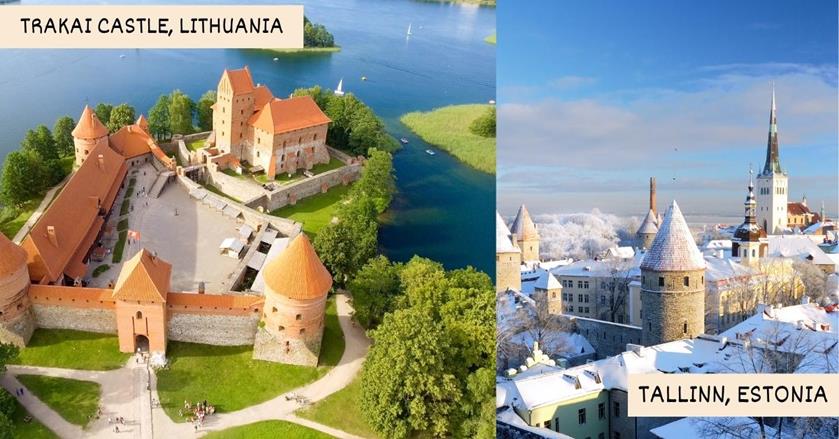
Lithuania for 5 days
Lithuania is rich in cultural preservation, so much so that UNESCO considered their folk dance as one of the intangible cultural heritages. They also have one of the oldest languages, even older than Greek, German, and Celtic, and the oldest tree in Europe could be found here as well.
With five days in Lithuania, you can do and see a lot of things. You can cover at least two major cities; the capital city Vilnius, and the cultural art city of Kaunas. If it’s warm enough, head to the coast and visit Klaipeda.
Here is a list of the best places to see in Lithuania:
- Gediminas Castle Tower in Vilnius
- Vilnius Cathedral Square
- Hot Air Balloon Flight – over Vilnius or Trakai Castle
- Energetikos ir technikos muziejus in Vilnius
- Museum of Occupations and Freedom Fights and A.Mickiewicz Memorial Museum in Vilnius
- MO Muziejus in Vilnius
- Gates of Dawn in Vilnius
- Three Crosses Monument in Vilnius – join a full-day tour from Vilnius
- Walk around Uzupis
- Trakai Castle near Vilnius
- Kaunas Castle
- Devils’ Museum in Kaunas
- Hill of Crosses near Šiauliai
Latvia for 4 days
You can go to Latvia from Lithuania by driving, riding a bus, plane, or taking the train. The most recommended option is through riding a bus as it is the cheapest and fastest. Latvia is also a great destination during summer. You can take a swim on its sandy beaches, lakes, and rivers.
You can either spend the entire 4 days in Riga, the capital city or take day trips to see Gauja National Park and Turaida Museum Reserve for example. You can also explore Riga on a segway tour .
Here are some of the top tourist attractions in Latvia :
- House of the Black Heads in Riga – get your ticket in advance
- Riga Cathedral
- Three Brothers, Latvian Museum of Architecture
- St. Peter’s Church
- The Freedom Monument in Riga
- Shop souvenirs at Riga Central Market – join a food-tasting tour
- Gauja National Park outside of Riga
- Rundale Palace and Museum ner Jelgava
Estonia for 4 days
To reach Estonia if you’re coming from Latvia, you could board a plane, ride a bus, take the train, or drive. The most recommended option would be to ride a plane as it’s the fastest, but the cheapest option would be to take the bus.
Estonia is very unique, they have islands but are inhabited – and that makes them interesting to visit. There, you can go fishing, sailing, canoeing, kayaking, and for those who love birds, birdwatching is a popular thing to do in Estonia.
Tallinn, the capital, is obviously the most popular destination. However, with 2 weeks in Europe, around the Baltics, you can also head to Parnu and Tartu – both are located in the south of Estonia. Go to Haeska, Kabili, and Matsalu for birdwatching and wildlife experiences.
Here are some of the sights to see in Estonia :
- Tallinn’s Old Town
- Lennusadam Seaplane Harbor in Tallinn
- Lahemaa National Parl – sign up to a day trip
- Patarei Prison Exhibition/Communism Prison in Tallinn
- Parnu’s Beaches
- Alpakafarm near Parnu
- Estonian National Museum in Tartu
- Tagurpidi Maja (Peapeal OÜ) / Upside Down House in Tartu
- TYPA Letterpress and Paper Art Centre in Tartu
- Kuressaare Castle in Saare
- Join a 3-hour food tour
Travelling around the Baltics is one of my favourite destinations and one I recommend if you’re on a budget. You will still experience the European culture, walk through the alleys and paves with cobbled stone, and eat delicious meals.
It’s honestly possible to travel here for around $1,000 for those on a budget . You will stay in a hostel and consume street food or grocery store meals. The tours also don’t cost that much. Accommodation is around $25 to $35 a night, but transportation is cheap.
$2,000 is the average cost where you get to have a private room and try out a few local restaurants. For a luxury trip, $3,000 will get you very comfortable.
Itinerary #4 East Europe: Hungary and Croatia or Romania and Bulgaria
East Europe is a massive region. You will have to choose 2-3 countries to cover during your visit and perhaps next time, you go to new places. Right now, we’ll only cover 4 destinations for your 12-day in Europe itinerary; Hungary and Croatia or Romania and Bulgaria.
Croatia has so much to offer, but in the last few years, being the filming location of Game of Thrones, this country attracted more tourists. Aside from that, they also have stunning waterfalls and gorgeous Adriatic Islands, among other landscapes.
Hungary on the other hand is famous for its ruin bars, paprikas, and goulash. It also has sought-after outdoor and public thermal bars and great nightlife. Outside the city, Hungary has a lot of nature preserves and can be an affordable ski destination in winter.
Bulgaria is the oldest country in Europe and has tons of hot springs. It’s undeniable how affordable Bulgaria is as a travel destination. It also sits right on the Black Sea, a popular spot during summer.
Nightlife in Bulgaria is another reason tourists come here for its affordability. Speaking of cuisine, the traditional Bulgarian food is something of a must-try.
Romania is famous for its Carpathian Mountains, Salt Mines, and Medieval Fortresses. Just like Bulgaria, it’s also located on the Black Sea. One might want to visit Romania since it’s famous for being the home of Dracula.
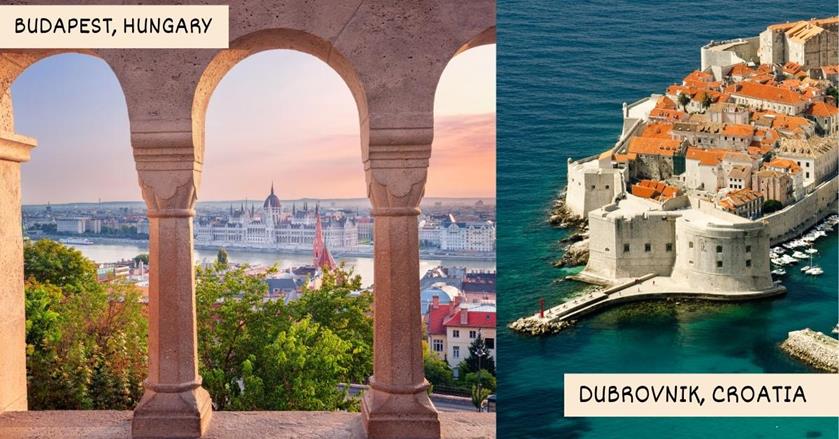
Hungary for 7 days
Hungary, like many other European countries, is a landlocked country. But it doesn’t mean you can’t enjoy summer in Hungary. This country has over 1,000 natural springs water, hence, the popularity of its thermal baths.
Budapest is not the only city worth visiting in Hungary, you should also consider Debrecen and Szeged. While Balaton Uplands National Park is the spot to you want to go hiking, join wine tours, and be around nature.
Here are some of the top tourist attractions in this country :
- Hungarian Parliament Building in Budapest
- Budapest’s Széchenyi Thermal Bath – book a full-day spa
- Buda Castle
- Buy souvenirs at Central Market Hall
- Take a boat cruise Danube River in Budapest – check cruise prices
- Matthias Church in Budapest
- Esztergom Basilica
- The Caves of Lillafured near Miskolc
- Lavender field at Tihany
Croatia for 7 days
It is relatively easy to travel to Croatia if you’re coming from Hungary as they are neighbouring countries. You could travel by bus, by train or by driving. Any option is fine, but the cheapest option would be to ride the night bus.
As mentioned before, Croatia is now popular for being the filming location for Game of Thrones, but there are other places to see in this magnificent country. Just like its neighbouring country of Italy, Croatia is also a fantastic beach destination and so much more affordable.
Zagreb is the capital of Croatia and a must-visit, then you can go to the coast. The most popular city is Split and Dubrovnik, but Zadar, Hvar, and Pula are an equally stunning area for swimming and other water activities.
Want to spend 14 days in Croatia ? Our guide has three itineraries you can check out and see which one suits you best.
Some of the top tourist attractions in this country include :
- Dubrovnik’s Old Town Walls – join a walking tour
- Trsteno Arboretum, Trsteno near Dubrovnik
- Dubrovnik’s Lovrijenac Fort
- Visit Game of Thrones filming locations – book a tour
- Nikola Tesla Technical Museum in Zagreb
- Diocletian’s Palace in Split – enjoy a walking tour with a local guide
- Blue Cave, near Split – book the 5 island boat tour
- Krka Waterfalls, near Split – visit on a boat tour
- Plitvice Lakes National Park near Zadar
- Kornati National Park near Zadar
- Euphrasian Basilica in Porec
- Pula’s Roman Arena
- Swim at Galebove Stijene in Pula
- Explore Brijuni/Brioni National Park near Pula
- Mulini Beach in Rovinj
Romania for 7 days
A massive country in East Europe, Romania has a lot to offer. From national parks, vibrant cities, historical sites, and beach access to the Black Sea. Bucharest is known for great nightlife, but apart from that, it’s also rich in cultural and historical spots.
Other than Bucharest, you have to go to the Transylvanian region, known as the home of Dracula. If it’s warm enough, head to Constanza, while Brasov and Cluj-Napoca are the areas to go to during winter for skiing and other winter activities.
Here are some of the places you could visit once you reached Romania:
- Romanian Athenaeum in Bucharest
- Grigore Antipa National Museum of Natural History in Bucharest
- National Museum of Romanian History in Bucharest
- Dimitrie Gusti National Village Museum in Bucharest
- Vaser Valley Forestry Railway
- Bran Castle aka Dracula’s Castle in Transylvania – book a tour combo with Peles and Brasov trip
- Sighisoara Historic Center
- Covered Stairway in Sighisoara
- The Clock Tower in Sighisoara
- The Black Church in Brasov
- Peles Castle near Brasov – book a 2-day tour from Bucharest to visit Brasov, Sibiu, and Sighisoara
- Bucegi Natural Park near Brasoc
- Transylvanian Alps
Bulgaria for 7 days
Just south of Romania, you can reach Bulgaria by train, bus, or driving. The quickest option would be to drive, which would take you more or less five hours, but the cheapest option is by riding a train.
Another country with the best nightlife, Bulgaria is popular with young tourists. But it doesn’t mean non-partygoers cannot enjoy Bulgaria. This country is a great place to explore the outdoors. There are many hiking trails and to ski here, you don’t have to spend too much.
Head to the capital city, Sofia, but for winter sports, you can go to Bansko, Borovets, and Pamporovo. If you are coming during the warm months, you can still go to the Black Sea by heading toward Varna.
Some of the top spots in Bulgaria are:
- National Palace of Culture in Sofia
- Sofia History Museum
- Rila Monastery – visit with combo tour to Boyana Church
- Seven Rila Lakes – check tour price from Sofia
- Tsarevets Fortress in Veliko Tarnovo
- Belogradchik Rocks
- Prohodna Cave in Karlukovo
- Krushuna Waterfalls
- The Rose Valley near Kazanluk
- The Ancient Theatre of Philippopolis in Plovdiv – join a tour of Plovdiv, Asen’s Fortress, and Bachkovo Monastery
- Pirin National Park near Plovdiv
- Thracian Tomb of Sveshtari near Shumen
East Europe is one of the most affordable regions in Europe. The accommodation alone can range between $20-$30 while food and the use of public transportation are also very affordable.
It’s easy to travel on a budget in eastern Europe, around $800 is feasible for backpackers and young travellers. If you want to be comfortable, $1,000 will be great and get you your own private room and dine at restaurants. $2,000 can easily be a luxury trip in this region for a 2-week adventure.
Itinerary #5 Nordic: Iceland, Norway, and Denmark
The next option would be the Nordic countries, which consist of Norway, Iceland, Sweden, Finland, and Denmark. However, in this itinerary, we will only cover Norway, Iceland, and Denmark.
Norway is also known as the Land of the Midnight Sun. It is famous for its fjords, lakes, and magical skies (Aurora Borealis), as well as Viking culture and folklore.
Iceland is also famous for a lot of natural wonders such as geysers, active volcanoes, and glaciers. You could also see the Northern Lights here. Iceland is relying 100% on renewable energy; hydropower, and geothermal.
Last but definitely not least is Denmark, which is well-known for its coastal towns, architecture, Royalty, and cuisine. Copenhagen is a must-visit. If you find yourself with extra time, you can hop on a train and head to Sweden.

Iceland for 4 days
Iceland is the land of fire and ice, and you might be wondering why. They have glaciers but have volcanically heated pools at the same time, where you could swim all year round. That’s pretty fascinating.
Aside from that, it is also a literary-focused country. In fact, one out of ten Icelanders will publish a book even at least once in their lifetime.
Iceland is not a big country, but spending four days here is plenty. Most tourists love staying in Reykjavik, but you don’t have to. If you want to save money, you can stay outside the city and rent a car instead. You can easily move around in your own car, which means it doesn’t matter if your hotel is not in the city.
We have a complete guide and itinerary for 2 weeks in Iceland .
Top attractions in Iceland:
- Drive the Golden Circle
- Blue Lagoon – get your ticket in advance including Kerid Volcanic Crater
- Gullfoss Falls
- Seljalandsfoss
- Silfra – snorkel between 2 tectonic plates between North American and Europe
- Þingvellir National Park
- Jökulsárlón
- Chase the Northern Lights – join a tour to find the best spot
- Icelandic Phallological Museum
- National Museum of Iceland
- Reykjanesfólkvangur
- Whale Watching near Reykjavik – book a cruise
- Eystri-Fellsfjara / Diamond Beach
Norway for 6 days
You will need to ride a plane to reach Norway if you’re coming from Iceland. The fastest route takes more or less 6 hours. However, the journey would be worth it because there are so many sights and sceneries once you reach Norway.
This includes the world’s longest road tunnel and the world’s most remote island, among others. This is also an amazing place to ski during winter.
Many tourists usually go to Oslo and Bergen, but you can also add Stavanger, Kristiansand, and Tromso to your itinerary of 2 weeks in Europe.
If you want to see Fjords, you have to head west; from Trondheim all the way down to Stavanger. Check our 2 weeks in Norway itinerary list if you only want to see this country.
Here is a list of some of the best places to visit in Norway:
- Bygdoy Peninsula in Oslo
- Vigeland Sculpture Park in Oslo
- Viking Ship Museum in Oslo
- Naeroyfjorden
- Akershus Fortress in Oslo
- Oslo’s Fjords – check tour prices or a cruise to Nærøyfjorden, Flåm, and Stegastein
- Hanseviertel Bryggen in Bergen
- Sognefjord near Bergen
- Osterrjod and Mostraumen near Bergen – join a cruise
- Pulpit Rock (Preikestolen), in Stavanger
- Lofoten Islands
- Geirangerfjord
- Arctic Museum in Tromso
- Find the Northern Lights from Tromso – book a guided tour
- Atlantic Ocean Road
Denmark for 4 days
To reach Denmark from Norway, the best would be to take a plane. There is also a car ferry service, but with a limited time, it’s not ideal. Denmark has the oldest Monarchy in Europe.
Denmark is a small country but popular not only in Europe but around the world. For many years, it has been voted the happiest country in the world. It’s also known for being safe for tourists, the home birth of lego, and has the oldest monarchy in Europe and the oldest flag in the world.
Naturally, visitors will go to Copenhagen, but since the country (excluding Greenland and the Faroe Islands) is not that big, 4 days in Denmark is plenty
You can explore the entirety of Copenhagen and even have time to go to Odense, where the famous children’s book author Hans Christian Andersen was born. You can actually get to the city centre from Copenhagen airport in just 13 minutes – a great way to save time.
Here is a list of some of the best attractions in Denmark:
- The Little Mermaid (Den Lille Havfrue) – explore Copenhagen in a day
- Freetown Christiania
- The King’s Garden
- Amalienborg
- Rosenborg Castle
- Tivoli Gardens – get your ticket in advance
- Botanical Garden
- The Round Tower
- Memorial Anchor
- Copenhagen Opera House
- Walk around Strøget
- Ny Carlsberg Glyptotek
- Christiansborg Palace
- Danish Architecture Centre
- Ofelia Plads
- Legoland in Billund
- Hans Christian Andersen’s Childhood Home
- H. C. Andersens House
Nordic and Scandinavia is undeniably the most expensive place to travel around Europe. Accommodation alone could run $100, and dining and consuming alcohol are costly as well. But taking the bus and train is a little bearable.
To ensure that you will enjoy your 2 weeks in Europe around this region, plan to spend about $2,000 . If you are on a budget, you can probably do it for $1,700 but no less. But for l uxury, your trip cost will really skyrocket up to $5,000 .
Itinerary #6 West Europe: The UK, Netherlands, and Belgium
The last itinerary option for your 2 weeks in Europe includes the countries the UK, Netherlands, and Belgium, also known as the west of Europe.
The UK is popular for many things, including its monarchy, culture, history, and performers. Being the home of four different countries; England, Scotland, Wales, and Northern Ireland, you can easily say that it’s worth a visit. From bustling cities, amazing hiking trails, pubs to check out, and castles to explore.
There are tons of iconic places in the Netherlands despite it being a small country. The Netherlands is famous for many things . Here, you’ll be able to see windmills, cheese markets, bulb fields, and earthenware, among others. The Netherlands also have plenty of historical spots to discover including Anne Frank’s House.
The last country on our list is Belgium. They have high-quality chocolates, hence the name Belgian chocolate. This country is also well-known for waffles and beer and is the home to NATO headquarters.

The UK for 6 days
There are many things to see in the UK, and six days is definitely not going to be enough. But don’t panic. If this is your first time here, list the attractions you really want to see first. The world-famous Big Ben, London Eye, and River Thames can all be found here, and that’s just in London.
If you have been here before, perhaps, you can now explore less popular areas. Perhaps, you can focus on hiking instead of being in the city or just spend 14 days in England only, especially if it’s your first time.
It’s undeniable that the UK has the most famous monarchy in the world. London alone has a lot of attractions related to the British Monarchy and historical places. In order to make the most out of your trip, the recommended duration of stay is at least five days.
ALSO READ: 2 weeks in the UK , 2 weeks in England , and 2 weeks in Ireland and Northern Ireland itineraries.
List of some best places to see in the UK :
- Tower Bridge
- Stonehenge – book a combo tour with Windsor Castle and Bath
- Buckingham Palace
- The British Museum
- Tower of London and Crown Jewels Exhibition – buy your ticket in advance
- Kensington Palace
- Madame Tussauds – get your skip-the-line ticket
- Shakespeare’s Globe
- St. Paul’s Cathedral
- Book a Harry Potter tour – Warner Bros. Studio
- Scotney Castle
- Bodiam Castle
- Warwick Castle
- Lake District National Park
- Dean Village
- Edinburgh Castle – book a skip-the-line tour
- Palace of Holyroodhouse
- Loch Ness, Glencoe, and the Scottish Highlands – check the tour price from Edinburgh
- Loch Lomond & The Trossachs National Park
- Titanic Belfast – join a guided tour
- Crumlin Road Gaol
- Giants Causeway – visit with a stop at Dark Hedges, Dunluce, and Belfast
- Free Derry Corner
- The Derry Walls
The Netherlands for 4 days
You could either ride the train or drive if you want to reach the Netherlands from the UK. Once you reach the Netherlands, you could experience the biggest ice skating tour in the world, or join a cycling tour. You can also know more about world-famous painters like Van Gogh and Rembrandt.
Four days sounds too little but you can actually do a lot while in the Netherlands. You can of course explore Amsterdam, and head to The Hague, Rotterdam, and Groningen.
Some things to see and do in The Netherlands:
- Jordaan and Amsterdam’s Canals – book the famous canal cruise
- Anne Frank House
- Rijksmuseum
- Mauritshuis
- Van Gogh Museum – enjoy with an audio guide
- The Windmills of Kinderdijk
- Hoge Veluwe National Park
- Valkenburg Castle Ruins
Belgium for 4 days
To reach Belgium, you could ride the train, ride a bus, use rideshare, or drive. The cheapest option would be to use rideshare and the most recommended option would be to ride the train. It would take you almost 3 hours to reach your destination.
The popular cities in Belgium are Brussels which is the capital, Ghent, Antwerp, and Bruges. You can take buses, trains, or rent a car to travel between cities. Don’t forget to go try different beers and waffles which are two of my favourite part of my visit.
Popular attractions in Belgium:
- Grand Palace
- Atomium – get your entry ticket in advance
- Sign up for the famous Hungry Mary’s beer and chocolate tour or join chocolate making class
- Manneken Pis
- Day trip to Bruges and Ghent – enjoy with a tour guide
- The Canals of Bruges
- Battlefield in Flanders
- Belfry of Bruges
- Basilica of the Holy Blood
- Bruges Beer Experience
- Sint-Salvatorskathedraal
- Gravensteen
- Museum Aan de Stroom
- The Rubens House
What I enjoy about travelling in western Europe is how it’s honestly a pricey place but it can be done on a budget. If you think you can stay on your feet for long hours and walking around is not a problem, you can easily cut costs by taking the bus or taxi. The accommodation will surely get you, but dining can be affordable.
The street food in all these countries is fun, globally diverse, and easy to find. For budget travellers, $1,700 is required for your 2-week trip and most likely requires you to stay in a youth hostel. $ 2,500 offers comfort and a bit of luxury where you can dine at nice restaurants. $4,000 means you can stay in hotels right downtown and near the top attractions, With this budget, you can even hire taxis during your entire trip.
SUMMARY OF 2 WEEKS IN EUROPE
There are so many countries to choose from if you plan to visit Europe. Fortunately, Europe has amazing transportation between cities and countries, making it easy to travel around even with limited time.
When planning your 14-day itinerary for Europe, don’t try to cram it too much. It’s better to travel a bit slower, see fewer places, but be able to enjoy and process everything you have seen and experienced. Europe is not going anywhere, you can always visit again and check out a new place.
I hope that you found these 2 weeks in Europe itineraries helpful in planning your own.
TO SAVE THIS ITINERARY, PIN THIS IMAGE BELOW:

- Adventure Planner New
The alternative award-winning way to travel Europe independently.
- What Makes it Unique
- How it Works
- Pick Up & Drop Off Points
- Our Accommodation
- Meet Your Travel Guides and Drivers
You choose where you go, how long you stay, and what you do.
Europe Trip Planner
- City Excursions and Activities
Get all the inspiration you need for your trip of a lifetime!
- The Best Destinations to Visit in Europe
- Hop-on Hop-off Travel Articles
- Book A Europe Pass
The ultimate flexible travel network in Europe and Asia.
- Europe Hop-on Hop-off
- Asia Unlimited Pass
Hand-crafted tours around the world run by our expert guides.
- Italian Adventure
- Turkey Aegean
- Vietnam Adventure
- Ultimate Scandi-baltic
- Morocco Encompassed
Sailing holidays and island-hopping trips to suit every style and budget.
- Croatia Sailing
- Greek Island Hopper
- Turkey Sail
- All In Croatia Sail
- Thai Islands Hopper
- Thai Islands Moon Party
Go beyond the destination and discover a side of it you didn’t know existed.
- Eastern Wanderer
- Roman Footprints
- Northern Highlights
- La Dolce Vita
Guided tours to the craziest cultural and music festivals and celebration.
- Tomorrowland
- Oktoberfest
- La Tomatina
- Ultra Croatia
- Sziget Budapest
- Lollapalooza Berlin
- Halloween Trek
Guided trips and ski packages through Europe’s winter wonderland.
- Ultimate Winter Adventure
- Eastern Festive Trek
- Scotland Highland Christmas
- Alpine Festive Trek
It can only happen in Europe. One day you’re on the Amalfi Coast savouring an Italian pizza, the next you’re in a beer hall munching bratwurst and pretzels.
- Croatia and the Balkans
- Eastern Europe
- Spain and Portugal
Roll through the legendary highways, the big cities, chill in National Parks and the sunniest beaches.
- West to East Roadtrip
- East to West Roadtrip
- East USA and Canada Adventure
- Western National Parks Adventure
- Canada Rockies
Our Asia trips suit all budgets and tastes. From Thai’s party islands and the vivacious Hanoi, all the way to the Angkor Wat and other incredible UNESCO sights.
- Unlimited Asia Pass
Ride camels across Saharan sand dunes, chill out on the golden surf beaches of Essaouira, barter in the bustling souks of Marrakech and get lost in ancient Fes.
- Morocco and the Sahara
Whenever you travel with us in Scotland and Ireland we'll cram in plenty of sightseeing, storytelling and authentic, real local experiences.
- Sustainable Tourism
- Travel Update
Plan your perfect trip. Pack your bags and go. We take care of all the rest.
Plan your perfect trip to Europe.
Create your route to Europe's most beautiful destinations. We'll book your accommodation and our expert travel guides will drive you from city-to-city by private bus transfer. You just relax and enjoy Europe in comfort.
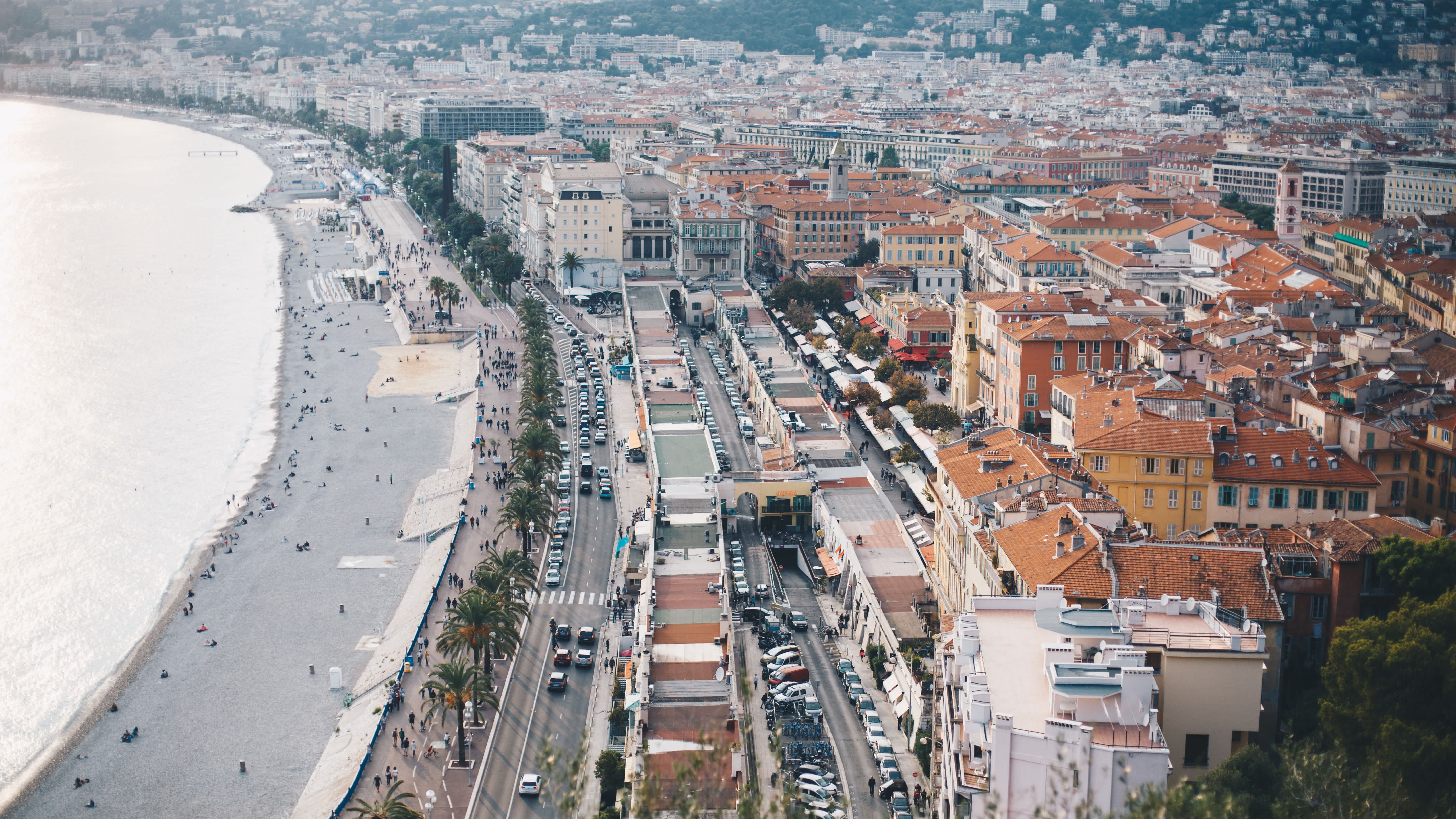
Due to the COVID-19 pandemic and travel restrictions in place globally, we will not be running any trips in 2021. Get more information on why this decision was made and read about suggested travel alternatives with our sister brands.
Create My Custom Trip From Scratch
Don't want to start from scratch? These popular routes are a great starting point to get inspired.
Each one of these itineraries can be tailored perfectly to your travel needs.
Popular Europe Tours
First time to Europe? Start here!
See itineraries
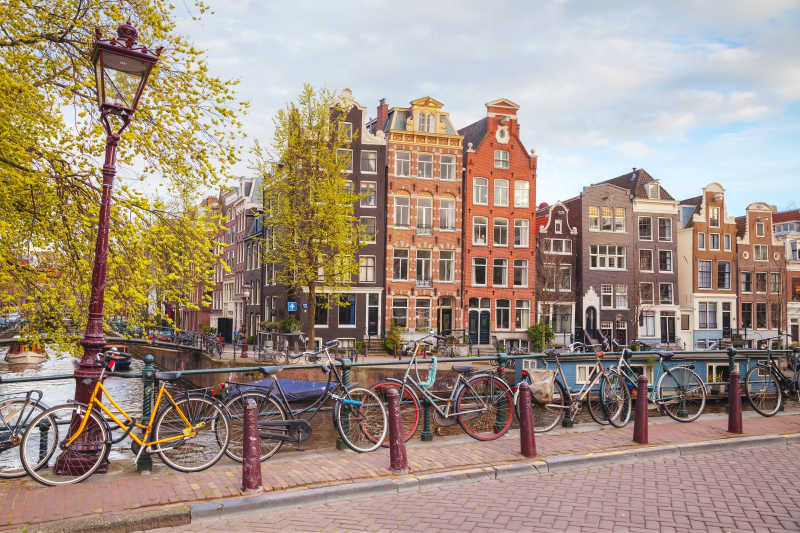
Trips for Travellers in their 30s and 40s
Routes covering unique destinations for more experienced travellers.

Sensational Swim Spots
Dive in to these epic itineraries

Staff Picks
Our favorite routes to get you started!
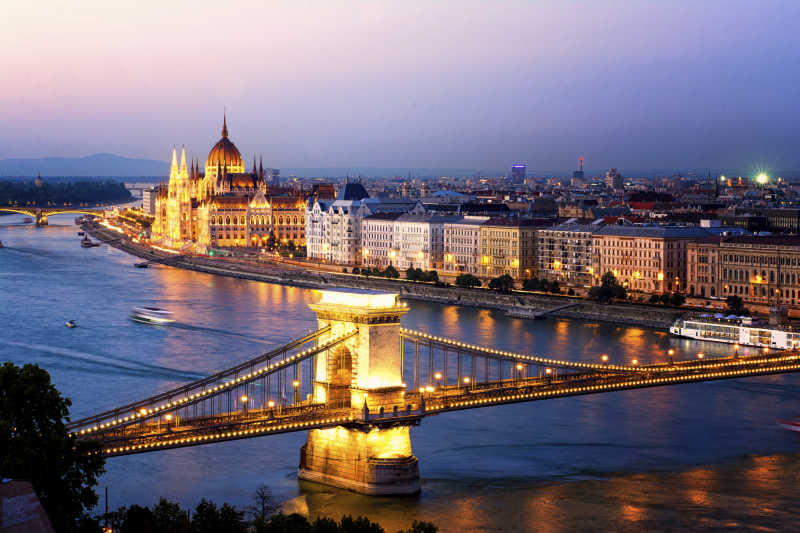
Travel Europe with Alex Dyson
Road to Lollapalooza

The Great Food Tour
Trips to sink your teeth into

2 Week Trips
The perfect taster of Europe
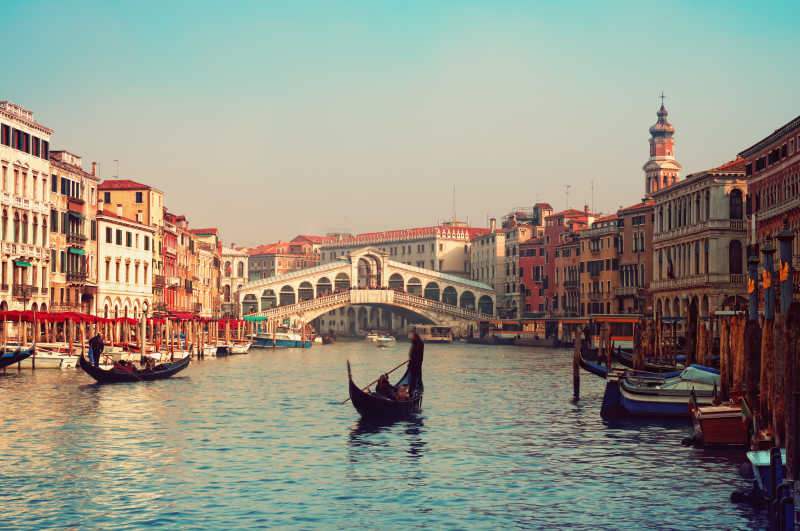
Coast To Coast
Life’s a beach on these coastal getaways.
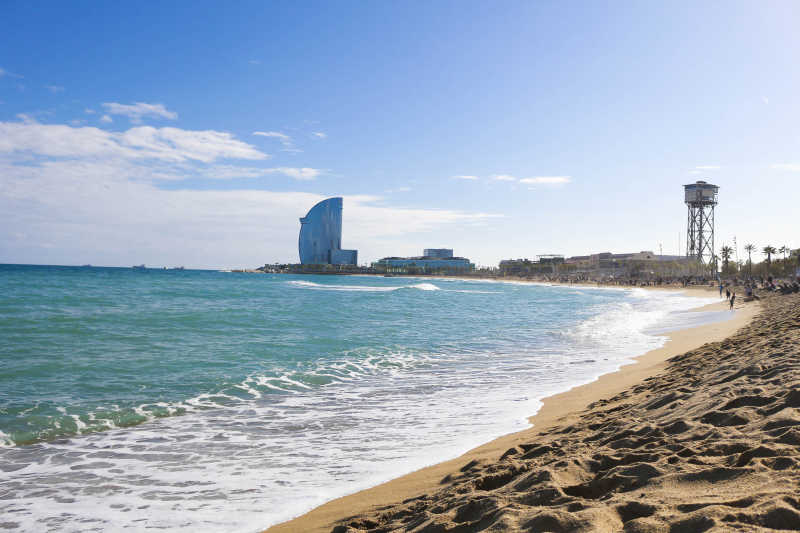
Weekend Breaks
Perfect trips for a long weekend.
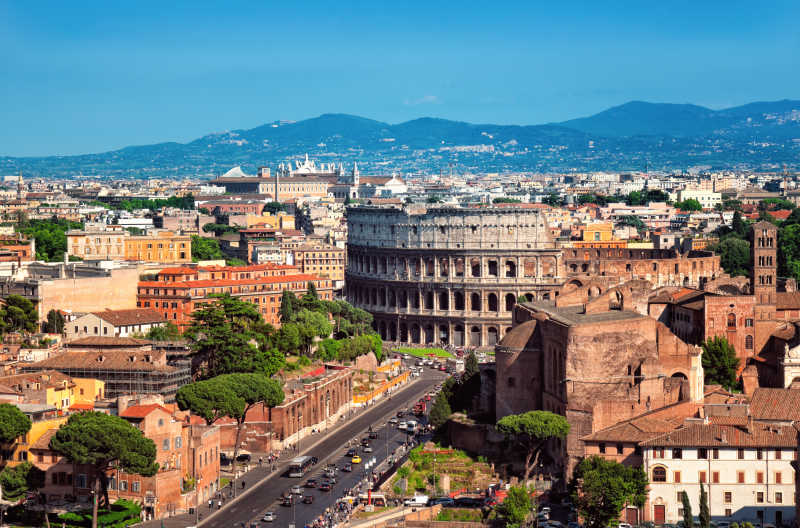
40+ itineraries
Choose from over 40 popular travel style itineraries
See all itineraries

We offer free travel planning advice at anytime. We'd love to talk to you about your travel plans!
As European travel specialists we have over 20 years of experience to share - and we'd love to hear from you.
Ask a Question

Still researching your travels? Check out our sister company

Find out more

- +1 877 668 4328
Your cart is empty
🌸 20% OFF JAPAN ESIMS ⏰ LAST CHANCE 👉 SHOP NOW

How Much Does a Europe Trip Cost from Australia?
Are you dreaming of a European adventure but unsure about the cost? Planning a trip to Europe from Australia involves considering various factors that can affect your overall expenses. From airfare to accommodation, transportation, sightseeing, and dining, it's essential to understand the potential costs involved. In this article, we will provide you with a comprehensive guide to help you estimate the expenses and plan your budget accordingly for a memorable Europe trip.
Table of Contents
Factors affecting the cost of a europe trip from australia, planning your europe trip, cost breakdown of a europe trip from australia, additional considerations.
Traveling from Australia to Europe offers a diverse and captivating experience. However, it's crucial to have a clear understanding of the expenses associated with such a journey. Let's explore the factors that can influence the overall cost and help you plan your European adventure within your budget.
- Airfare : The cost of flights is typically one of the significant expenses when planning a Europe trip from Australia. Factors like the time of year, airline, and booking in advance can significantly impact the price.
- Accommodation : Depending on your preferences, accommodation costs can vary greatly. Options range from budget hostels to luxury hotels and vacation rentals. The location and the level of comfort you seek will influence the price.
- Transportation within Europe : Getting around Europe involves additional costs, including train tickets, intercity flights, or rental cars. The distance between destinations and the mode of transportation you choose will affect your expenses.
- Sightseeing and Activities : Exploring Europe's famous landmarks, museums, and attractions often involves entrance fees. Planning your itinerary and considering the costs of various activities is crucial.
- Food and Dining : Dining out and trying local cuisine is an essential part of any trip. European cities offer a range of dining options, from budget-friendly street food to high-end restaurants. The number of meals you eat out and your dining preferences will impact your expenses.
- Miscellaneous Expenses : Additional expenses may include visa fees, travel insurance, shopping, and unforeseen costs. It's essential to allocate a budget for miscellaneous expenses to avoid any financial surprises.
To make the most of your Europe trip and stay within your budget, proper planning is key. Consider the following steps when organizing your adventure:
- Setting a Budget : Determine the maximum amount you are willing to spend on your trip. This will help you make informed decisions regarding your itinerary and expenses.
- Choosing the Right Time to Travel : Prices for flights and accommodation can vary depending on the season. Traveling during off-peak or shoulder seasons can often result in more affordable rates.
- Selecting Destinations : Research and decide on the European destinations you wish to visit. Consider the cost of living in each country, as expenses can vary significantly.
- Booking Flights and Accommodation : Look for the best deals on flights and accommodation by comparing prices online. Booking in advance or taking advantage of last-minute deals can save you money.
- Researching Local Transportation Options : Understand the transportation systems in each city you plan to visit. Utilize public transport, consider rail passes, or rent a car based on your needs and budget.
- Pre-Booking Sightseeing and Activities : Many attractions offer discounted rates for pre-booking tickets online. Research popular sights and activities in advance and take advantage of any available discounts.

To give you a better idea of the potential expenses, let's explore a sample cost breakdown for a two-week Europe trip from Australia:
- Sample Itinerary and Expenses : Create a detailed itinerary with estimated costs for accommodation, transportation, sightseeing, and food for each destination you plan to visit.
- Average Daily Expenses : Calculate the average daily expenses by considering accommodation, meals, transportation, and sightseeing costs. This will help you determine a reasonable daily budget.
- Tips to Save Money : Explore money-saving strategies, such as staying in budget-friendly accommodations, opting for public transportation, cooking some meals yourself, and taking advantage of free attractions and walking tours.
While estimating the cost of your Europe trip, don't forget to consider the following factors:
- Travel Insurance : Protect yourself and your belongings by investing in comprehensive travel insurance that covers medical emergencies, trip cancellations, and lost baggage.
- Currency Exchange : Familiarize yourself with currency exchange rates and fees. Consider using a prepaid travel card or withdrawing cash from ATMs to avoid excessive charges.
- Language and Communication : English is widely spoken in many European countries, but it's helpful to learn a few basic phrases in the local language. Consider carrying a translation app or phrasebook for ease of communication.
- Health and Safety : Check if any vaccinations are required before traveling to certain European destinations. Familiarize yourself with local customs and emergency contact information to ensure a safe and healthy trip.
A Europe trip from Australia offers an incredible opportunity to immerse yourself in the rich culture and history of this diverse continent. By understanding the factors that influence the cost and planning your trip meticulously, you can create a memorable experience that suits your budget. Remember to research and compare prices, book in advance when possible, and allocate a realistic budget for each aspect of your journey. Start your adventure today and get ready to create lasting memories in the beautiful countries of Europe.
Thanks for visiting our blog, are you planing to travel to Europe? Check out our Europe SIM card .
Before you take off make sure to check with local government of the travel status.
Leave a comment
All comments are moderated before being published
Why we need activation dates?
- We need these dates to activate your SIM card so you can use them when you’re ready to travel.
- If you don’t give us an activation date, your SIM card will not work when you plug them into your phone.
Not sure on your dates yet?
- You can add in an estimated date for your SIM. Your SIM’s data & validity won’t start until you plug it into your device.
- Once you know your exact dates, please let us know via our live chat or at [email protected] so we can activate it for you at the right time.
What if you need to change the dates?
- You can reach out to us via our live chat or at [email protected] with your SIM number so we can change it for you.
- International edition
- Australia edition
- Europe edition

Europe’s longest hyperloop test track revives futuristic tube transport hype
Operators hope newly opened Dutch track will help prove feasibility of high-speed shuttle system
The longest hyperloop test track in Europe has opened, raising faint hopes once more that the maglev meets vacuum tube transport technology could be the future.
Operators said the facility would help prove the hyperloop’s feasibility, saying it could allow a 6,200-mile (10,000km) network of high-speed tubes to be in place around the continent by 2050.
As it stands, the European Hyperloop Center test bed in Veendam is not so much a loop as a 420-metre-long forked white pipe running alongside the railway and road that must still be used, for now, to transport people around this corner of the Netherlands .
Made of 34 interconnected prefabricated 2.5-metre-wide steel cylinders, the partly EU-funded test pipe is somewhat shorter than the 2-mile track envisaged in 2020 , and allows speeds of only a fraction of the 620mph (1000km/h) that proponents believe the technology can achieve.

The fork in the Vandeem pipe will allow engineers to test what happens at a “lane switch” when a high-speed vehicle changes course. First tests will be carried out by the Dutch company Hardt Hyperloop in the coming weeks.
The centre’s director, Sascha Lamme, said it was a “pivotal moment”, telling Agence France-Presse: “You need this to create a network. The lane switch is a diverging part of the infrastructure, so one part goes for example to Paris, the other one heads off to Berlin.”
after newsletter promotion
The idea of the hyperloop was floated by Elon Musk in 2013 , who proposed a line linking San Francisco and Los Angeles, using magnets to propel shuttles along pipes in near-vacuum conditions, with the lack of friction and air resistance potentially allowing the vehicles to rival the speed of aeroplanes.
His fellow tycoon Richard Branson continued to put the hype in hyperloop with a Virgin-branded company testing a passenger capsule in the Nevada desert in 2020. He sold up and the renamed Hyperloop One collapsed last year.
While past predictions for the hyperloop have appeared unduly bold, Lamme maintained a pan-European network could appear in a few decades. “If you look at how highways were developed over time, it goes exponentially when the technology is ready. It should really be possible to get into a station in Amsterdam and travel to a city like Barcelona in two hours.”
Supporters say the hyperloop offers potentially cleaner and quieter as well as quicker transport, although passengers may balk at the idea of travelling in a windowless pod hurtling through an airless tube. Lamme suggested reluctance could be overcome with “a capsule with a nice ceiling which might display stars or a nice sunny day”.
Europe’s innovation may yet allow it to keep up with developments in China, which opened a one-mile test track for “low-vacuum pipeline magnetic levitation technology” in Shanxi province in 2022, according to state media.
- Netherlands

First passengers travel in Virgin's levitating hyperloop pod system

Amsterdam to Paris in 90 minutes? Dutch tout hyperloop as future of travel

Labor rebuffs Elon Musk’s ‘hypothetical’ Hyperloop to solve Australia's transport woes

Is Richard Branson’s high-speed train in a pneumatic tube pie in the sky?

Richard Branson’s Virgin Group invests in Hyperloop One

Is Elon Musk's plan for a road network beneath LA more than a pipe dream?

Elon Musk: Boring Company commits to 600mph Hyperloop and tube network

'Faster, cheaper, cleaner': experts disagree about Elon Musk's Hyperloop claims
Most viewed.

IMAGES
COMMENTS
Welcome to Triptile, your ultimate online tour planner for global adventures. While Europe remains a focal point, we offer over 3,990 locations worldwide to explore. With 7,625 hand-picked activities and 436 customizable templates, craft your dream journey with ease. Start planning your next unforgettable escape with Triptile today.
April 26, 2022. How I Planned a 6 week European Holiday (Plus download my detailed Itinerary) As I'm sure most people (especially Australians) would agree, COVID hung around a lot longer than I thought it would. With international travel finally back on the cards, I'm starting to plan future trips, particularly future holidays to Europe.
With Wanderlog's mobile travel planner on Android and iOS, access and edit your trips wherever you go — even while offline. 4.9 on App Store, 4.7 on Google Play. Keep your places to visit, flight/hotel reservations, and day-by-day itineraries for your trip to Europe in our web and mobile app vacation planner.
Use our Europe trip planner map to create your own self-guided route, including any major European destinations - plus some further afield including Russia and China!. The map tool is interactive and super easy to use; you can make a plan without any obligation to book your trip with us. We'll then send you over our best ideas for your route, plus a price including all your trains and ...
1. London, England. Australian history is split into two main categories: before and after the European invasion. If you want to learn more about the European side of things, a trip to England should be your first stop. London's history can be seen in its architecture, from Buckingham Palace to the Tower of London and Westminster Abbey.
Here are some basic guidelines for how many places you can visit depending on how much time you have: With 7 days: 2 cities OR one city with day trips. With 10 days: 3 cities OR 2 cities with day trips. With 14 days: 4 cities OR a road/train trip through one or two countries. Barcelona, Spain.
With one week in Europe, you can explore two amazing cities in central Europe, Budapest and Vienna, and day trip to the smaller, underrated city of Bratislava. All three cities are connected by direct trains so planning your trip and getting around is a breeze. Fly into Budapest and fly home from Vienna. This itinerary works great in either ...
In short, the workbook contains 30 pages of helpful information and worksheets designed to guide you through the research and planning process for your Europe trip! With it, you'll go through all the following steps: Understanding the Schengen Area. Choosing how much time to spend in Europe. Choosing where/when to go to Europe.
Transform your travel planning with the AI-powered 80days.me app. Download from the App Store and quickly craft unforgettable multi-destination adventures, complete with flights, trains, and ships. Unleash the joy of hassle-free multi-city Eurotrips with 80days.me. Our AI-powered planner simplifies your travel experience, offering personalized ...
Use our route planner to map out your journey around Europe and book the best accommodation. Plan your Eurotrip with Eurail Planner, the free rail planning tool. ... Our free app makes it easy to plan and book everything you need for your trip around Europe. Map. Plan the best route across Europe and see your eurotrip come to life. Itinerary.
Beach - places like Ibiza, Majorca, the Greek islands, and Capri are great beach destinations; Christmas - Europe has the best Christmas Markets and really knows how to get you in the holiday mood. Check out my blog post on some of the best Christmas Markets in Europe.; City/Culture - Destinations such as Paris, Brussels, and Zurich are great options for art museums, history, and so much ...
2. Establish a budget. When planning a trip to Europe, establish a budget as early as possible—even before you know your destination, travel dates, or itinerary. Some destinations are generally ...
With Eurail, you can plan your own rail route, choosing from 30,000+ destinations in 33 countries. Take your pick from the countries below and see where you can go with our railway map. Download the Eurail map. Austria.
Day 15 to 18. Next up on our three-week Europe itinerary is Athens, the birthplace of modern democracy and Western civilisation. Once one of the world's most influential cities, Athens is full of ancient monuments to marvel at, like the Parthenon and the Panathenaic Stadium.
How Rome2Rio works. Rome2Rio searches any city, town, landmark, attraction or address across the globe with thousands of multi-modal routes to easily get you from A to B. 198,965. Train Lines via. 6,002 Train Operators. 969,666. Bus Routes via. 79,538 Bus Operators. 13,273.
1. Understand the Schengen Area. Alright let's start with the very first step of planning your own trip to Europe. Before we get into the topic of visas and entry requirements, we need to talk about something called the Schengen Area.. A lot of people falsely assume that border-free travel exists all throughout Europe, but that's not actually true.
HOW TO PLAN A TRIP TO EUROPE STEP BY STEP: ️ Grab my free Europe trip planning workbook: https://happytowander.com/EuropePlanningWorkbook ️ Read the blog p...
destinations and dates. Choose a popular itinerary, or a classical journey, or an AI-generated itinerary to create your perfect trip. Select flights, hotels, car rental and city experiences. Book your travel services. through RoutePerfect and. receive your free travel.
For young visitors and backpackers, you can probably get away with $1,000 to $1,500 for the 2 weeks trip. Accommodation in Germany, Switzerland, and Austria is costly but affordable in Poland and Czechia. Rely on using public transportation in all countries, such as buses and trains, instead of renting a car or flying.
We offer free travel planning advice at anytime. We'd love to talk to you about your travel plans! As European travel specialists we have over 20 years of experience to share - and we'd love to hear from you. Ask a Question. Create your own tailor-made itinerary with Busabout. Create itinerary from scratch or use hundreds of existing itinerary ...
These Central Europe trip packages provide top sights, centrally located hotels, guided programs, and private transfers. Explore the best of Central Europe with a choice of private or small group tour program that takes an exciting week or a remarkable 18-days trip to Prague, Vienna, Budapest, Warsaw, Munich, and other popular cities. Delight ...
Planning Your Europe Trip. Cost Breakdown of a Europe Trip from Australia. Additional Considerations. How I Travelled Europe On A Budget (about $40/day) Watch on. Traveling from Australia to Europe offers a diverse and captivating experience. However, it's crucial to have a clear understanding of the expenses associated with such a journey.
Triptile is the perfect tool for you to plan a trip not only to European countries such as Italy, France and Spain but also outside of Europe to places in Scandinavia, Asia, Oceania, Alaska and virtually anywhere. You can use any of the services available on Triptile or add your own. You don't have to make reservations with us but you can ...
The longest hyperloop test track in Europe has opened, raising faint hopes once more that the maglev meets vacuum tube transport technology could be the future.. Operators said the facility would ...